The Boundary Waters: The Complete Guide
:max_bytes(150000):strip_icc():format(webp)/Becker1-5b734a56c9e77c0025caddbd.jpg)
BlueBarronPhoto/Getty
Located along the U.S.-Canadian border between Minnesota and Ontario, the Boundary Waters have been a popular destination for explorers, adventurers, and active travelers for decades. Spread out over more than a million acres of wilderness, this region is made up of dense forests, sprawling lakes, and a spiderweb of interconnecting rivers and streams. For anyone looking to get away from it all, this is a place where you can leave the trappings of civilization behind and immerse yourself in nature that has remained largely untouched by man for centuries.

History of the Boundary Waters
Carved by glaciers more than 10,000 years ago, the Boundary Waters are made up of striking landscapes that feature rolling hills, broad valleys, and seemingly endless forests. Its countless waterways form a natural border between the U.S. and Canada, flowing eastward towards Lake Superior. These waterways were often used by early explorers and fur traders who helped open North America during the 17th and 18th century.
When referring to the Boundary Waters, most people associate it with the Boundary Waters Canoe Area Wilderness , a large protected area that was established in 1964 as part of the US. National Park system . In reality, the broader Boundary Waters region is made up of several subsections which also include Superior National Forest, Voyageurs National Park and Grand Portage National Monument on the American side of the border, and Quetico and La Verendrye provincial parks in Canada. Collectively, each of these areas makes up the Boundary Waters, creating a massive outdoor playground for those adventurous enough to experience it all.
How to Get There
Located in the far north of Minnesota, just reaching the Boundary Waters can be a bit of an adventure. Those traveling by plane will likely fly into Minneapolis or possibly Duluth, but even then a long car ride is required to reach this beautiful wilderness. You'll need to budget five to six hours of drive time from Minneapolis or two to three hours from Duluth. That drive is a scenic one however, quickly leaving urban settings behind in favor of the dense Northwoods. Sharp eyed travelers may even be able to spot deer, moose, or even black bear along the way.
For the absolute best driving experience, make your way along the 57-mile Gunflint Trail, a national scenic byway that begins in the town of Grand Marais and ends at the Trail's End Campground, a good launching point for a Boundary Waters adventure. The drive, which approaches the Boundary Waters from the east, is remote and beautiful from start to finish. That said, there aren't many places to stop or resupply along the way. Be sure to have full gas tank and plenty of road trip snacks before setting out.
Those coming from the west can start their Boundary Water experience in Ely, Cook, or Crane Lake. These quaint little upper-midwest towns are friendly, accommodating, and a great place to purchase last minute supplies before leaving civilization behind for awhile.
What to Expect
As already noted, the Boundary Waters are a remote and wild destination. Visitors can expect miles of dense forest on their drive to the border area, where they'll discover dozens of interconnected rivers and more than 1,175 lakes of varying sizes. Wildlife is in abundance, throughout the region too, including more than 200 species of birds to go along with the deer, moose, wolves, lynx, black bear, and more than 40 other types of animals. Visitors are advised to take caution when encountering those creatures. Although they are seldom aggressive, they can be dangerous when surprised or cornered.
Travelers shouldn't expect much in the way of amenities while in the Boundary Waters, including cell phone service. The wilderness area is located miles from any urban environment, which means don't expect to be sending text messages, making phone calls, or sharing photos on social media. In fact, once you enter the protected area, there are almost no manmade structures to be found, leaving the region almost completely untouched by humans. So much so that even aircraft are prohibited from flying below 4,000 feet while over the Boundary Waters, something that no other wilderness area in the U.S. can claim.
One of the best things about spending time in the Boundary Waters is just how peaceful and quiet it can be. Because it is located in such a remote place, visitors typically only hear the sound of the wind, the water, and the call of wild animals. At night, it is a dark zone, far from any city lights. That makes it a great spot to go stargazing, free from light or air pollution.
Things to See and Do in the Boundary Waters
The Boundary Waters are a dream destination for outdoor enthusiasts. With more than 1,200 miles of canoe routes to paddle, 12 long-distance hiking trails to walk, and 2,000 designated campsites to pitch a tent, visitors can spend a lifetime wandering this wilderness and still only see a fraction of what it has to offer.
When visiting the Boundary Waters, travelers will have to make two choices—how long they want to stay and how they want to explore the area. Most come for just a few days, camping, hiking, and canoeing on the edges of the wilderness. Some will venture further into the interior of the region, something that can only be accomplished by canoe or kayak. A few will even paddle the Boundary Waters from end to end, spending upwards of two weeks in the backcountry along the way.
Part of the fun of visiting the Boundary Waters is setting your own itinerary and exploring the areas that most call to you. But if you have a limited time or are looking for some direction, try canoeing on Sea Gull Lake, an easily-accessible body of water that is generally calm, beautiful, and fun. On sunny days, its waters turn to a stunning shade of blue as well, providing an extra level of tranquility.
Hikers will find numerous trails to wander, both short and long. For instance, Big Moose Lake Trail is 2.5 miles out and back, and is great for stretching your legs in some wonderful scenery. Meanwhile, Eagle Mountain Trail is 3.5 miles in length and climbs to the highest point in the state of Minnesota. Backpackers looking for a significant challenge should put the Kekekabic Trail on their bucket list, as it is 38 miles of pure backcountry bliss.
Camping is a popular activity in the Boundary Waters of course, with literally hundreds of campsites available. The vast majority of those campsites are primitive in nature, without running water or other facilities. Many are located in remote areas only accessible by canoe, so be prepared to fully self sufficient while in the wild.
Unsurprisingly, anglers will find plenty of great fishing spots in the Boundary Waters too. The waters that make up the region are teeming with smallmouth bass, northern pike, and walleye. If you fancy yourself a fisherman or woman, pack your pole and tackle box. You'll be hard-pressed to find better opportunities to land a big one anywhere else in the continental United States.
Where to Stay
As mentioned, there are more than 2,000 designated campsites located throughout the Boundary Waters, allowing visitors to pitch their tent in the vary heart of the wilderness. Camping is of course the best way to experience this amazing destination, so bring a good tent, comfortable sleeping bag, and all of the gear you'll need for your stay. If you do plan on camping, keep in mind that you'll need a permit for backcountry travel at all times of the year. You'll also need a reservation for campsites during the busiest time of the year, which falls between May 1 and Sept. 30. Those permits can be obtained at recreation.gov .
Those who prefer not to camp while visiting the Boundary Waters have a few options to choose from. Hotels and lodges can be found in Grand Marais, Ely, Cook, and Crane Lake. You'll want to book your stay well in advance of course, and staying in one of those towns means you'll be commuting back and fourth throughout your visit.
You'll also find some rustic lodges located throughout the region. Places like the Gunflint Lodge , the Bearskin Lodge, and the Clearwater Historic Lodge are more conveniently placed and offer good access to the wilderness. In addition to accommodations, they can also organize outings or provide gear and supplies for day trips too.
When to Visit
The peak travel season in the Boundary Waters is in June, July, and August. The weather is fantastic, with warm days and cool nights, making it a perfect time to camp out in a tent. Of course, this is also the busiest time of year, which means more traffic on the roads, busier campsites, and crowds on some of the more popular trails.
If solitude is what you seek, then wander deeper into the Boundary Waters to escape the influx of visitors or visit during the shoulder season taking place in May and September. The upside of visiting during this time of the year is that the seasonal stores, shops, and lodges are all open for business. During the colder months, many of those outlets shut down or operate on a reduced schedule. That means that while you'll be avoiding the busy tourist period, you may have to plan further ahead in order to have all of the supplies and gear that you'll need for your journey.
Autumn comes early in northern Minnesota, but it is utterly spectacular in the Boundary Waters. The leaves change to an array of brilliant colors, making it a great time to be in the wilderness. It is often less crowded during this time of year, though a steady flow of leaf peepers can line the roadways. Once again, getting into the backcountry will help avoid the traffic and provide for a wonderful adventure at the same time.
Winter can be long and harsh in the Boundary Waters, but if you enjoy cold weather outings there is much to like in this part of the country. Cross country skiing and dogsledding can take you deep into the backcountry, where you'll discover a wilderness that is empty and quiet. Only experienced adventurers should consider making such a trek, but those that do will be rewarded with endless miles of trails and frozen waterways all to themselves.
The 8 Most Adventurous Things to Do in Tahoe
The Best Places to Go Camping in Olympic National Park
Camping in Whitefish, Montana and Glacier National Park
The Best US National Park for Every Outdoor Activity
Voyageurs National Park: The Complete Guide
The 9 Best Hiking Trails in Nashville
10 Best Things to Do at Land Between the Lakes, Kentucky
Yosemite National Park: The Complete Guide
Mohican State Park: The Complete Guide
The Most Dog-Friendly National Parks in the U.S.
Bryce Canyon National Park: The Complete Guide
McArthur-Burney Falls Memorial State Park: The Complete Guide
Banff National Park: The Complete Guide
Hanging Rock State Park: The Complete Guide
Smith Rock State Park: The Complete Guide
The Complete Guide to Oklahoma's Beavers Bend State Park

Boundary Waters Outfitters
Boundary Waters outfitters, River Point Outfitting Co., is committed to making your BWCA canoe trips successful and memorable adventures. You can depend on River Point’s years of wilderness experience providing expert advice and it’s Paddle the Quiet Side ® location where the South Kawishiwi River joins Birch Lake at the doorstep of the famous Boundary Waters Canoe Area BWCA.
History and family tradition are the foundation of River Point Outfitting Co. Family-owned and operated, the site of River Point is steeped in a rich history and family tradition. It has been in the same Minnesota family, the Koschak family, for 78 years and before that the Laurel Indians (dated 500 B.C.) called this tranquil northern wilderness peninsula near the Boundary Waters Canoe Area their home. Read more»
Situated on a secluded mile-long wilderness peninsula in the Superior National Forest just 4 hours from Minneapolis and St. Paul, MN, and a short 8.5 miles from the quaint town of Ely, Minnesota, BWCA outfitters, River Point Outfitting Co. has a magnificent private lakefront location under a canopy of birch and pine trees.
BWCAW Permit System
Give River Point Outfitting Co. a call and we can help with all the planning and secure the necessary permit(s).
We’re here 7-days a week to help plan your paddling adventure! 218-365-6604
River Point Outfitting Co. is Ready to Service Your BWCA Canoe Trip
Boundary waters outfitters – ely outfitters™.
“We are stewards of the land and water…and, have been for four decades. Let us share our passion and love of the Boundary Waters with you.”
-Steve & Jane Koschak and James Koschak & Krista Jonson
Discover Captivating Natural Beauty
Your BWCA trip….because the naturally beautiful and equally amazing million acre Boundary Waters wilderness just 4 paddle miles away, River Point Outfitting Co., Ely Outfitters™, is your best choice for a Paddle the Quiet Side® BWCA canoeing experience. The Boundary Waters is yours to discover. Your adventure is waiting.™
BWCA outfitter, River Point Outfitting Co. has the strategic distinction of being the only lake-based Boundary Waters outfitters with doorstep paddle access to and from eleven different entry points in the Boundary Waters Canoe Area of Ely, Minnesota. The conduit providing this incredible access to and from so many entry points for your BWCA trip is the scenic and beautiful South Kawishiwi River right where River Point is located.
The South Kawishiwi River, BWCA entry point #32, is the east border of River Point and allows for diverse canoe routes to explore for any number of days. Know that River Point Outfitting Co. also services all entry points into the Boundary Waters in the Ely/Isabella area for your BWCA trips. Because of this you can be assured that premier Boundary Waters outfitters, River Point Outfitting Co., will provide you with the finest equipment and expert service and a great route for your special canoeing adventure. Go with the Pros!
Your Adventure Is Waiting…..Paddle the Quiet Side® Ely Outfitters ™

Explore River Point

Enjoy exploring the River Point Map to reveal the BWCA trip headquarters, Chalet or Villa lodging options, beaches, hiking trail, and More »
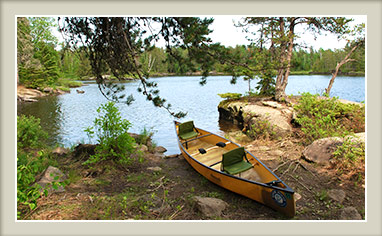
Reserve Comfort Plus™
Roughing it has never been so easy with our most popular Comfort Plus ™ Complete Package Read More »
Rent Canoes
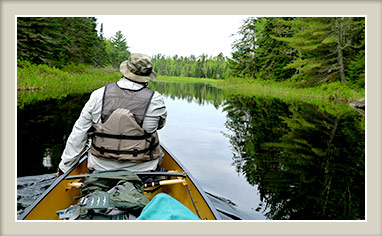
We are full-service Boundary Waters Outfitters with a tradition of excellence in equipment, canoes, and professional guest services since 1944. Learn More »
Your Adventure is Waiting™
Give Ely, MN and River Point Outfitting Co.-Ely Outfitters™- a try. You’ll love us! Boundary Waters Outfitters for BWCA canoe trip fishing expeditions, and incredible wilderness adventures. BWCA outfitters….go with the Pros! Explore Boundary Waters Fishing Options »

BWCA Canoe Trips
Are good for your soul, easy on your budget, and a perfect workout. You won’t even miss the gym. Fresh air …endless. Loon calls …peaceful. The experience …priceless!
Immerse In Unparalleled Serenity™
Serenity and peacefulness describe the Boundary Waters Canoe Area wilderness experience. Backpackers, birdwatchers, fishing enthusiasts, and photographers can find tranquility in enjoying Boundary Waters canoeing with its lush, deep green forests and clean lakes and rivers.
The option to “paddle back” to River Point , your expert Boundary Waters Outfitters, on the last day of your trip on the scenic, yet wild, South Kawishiwi River is most serene and gratifying. Four short portages take you around the bubbling rapids and provide some great photo opportunities. So, for your BWCA trip, we’ve got you covered!
Boundary Waters Outfitters Ely, Minnesota, that’s River Point Outfitting Co.
Rejuvenate Your Mind & Spirit™
Paddling has a way of relaxing the mind and soothing the spirit. Let your mind wander, let your worries wash away. Let the solitude and peace envelop you because that’s the way of the canoe.
“There is magic in the feel of a paddle and the movement of a canoe, a magic compounded of distance, adventure, solitude, and peace. The way of a canoe is the way of the wilderness and of a freedom almost forgotten, the open door to waterways of ages past and a way of life with profound and abiding satisfaction.
-Sigurd Olson
Gaze At Dancing Stars & Northern Lights™
The aurora borealis , or Northern Lights, are a spectacular light show in the northern skies when least expecting it. A phenomenon that truly is something to observe, but it is also not as readily seen as the millions of dancing stars that appear each night in the Boundary Waters. Your BWCA trip will be enhanced with a life-long memory if you are fortunate enough to view the stunning beauty of the Northern Lights.
RESERVE YOUR BWCA CANOE TRIP NOW
Now is the time to reserve your Boundary Waters canoe trip with River Point Outfitting Co. Ely Outfitters™. BWCA trips are amazing, and USFS Travel Permits always sell quickly so reserve your paddling adventure soon.
Call Today! We’ll take care of everything! 1-218-365-6604
River Point Outfitting Co. | Boundary Waters Outfitters Ely, Minnesota
River point resort & outfitting co. facebook..
River Point Resort and Outfitting Co.

The River Point Gift Shop is fully stocked with brand new merch for the Season. Come check it out!#riverpointresort #elymn #birchlakemn #kawishiwiriver #mnfishing #pontooncruising #mnsunsets #koozies #riverpointroadtakesyouthere @hasbargencustoms ...

Share on Facebook Share on Twitter Share on Linked In Share by Email
- Comments: 5
Comment on Facebook
Great looking shirts. Love the color choices, too. Way to go!!
Can you order shirts on line for shipping?
Do you have any sweatshirts??
Love these so much!
Nice looking shirts. 🤗
View more comments
“UP NORTH” It’s the place people go to escape, a place made of cabins, pine trees and lakes. But no matter how far you drive, There’s no sign to say “you’ve arrived.” So just follow your heart until you find, your special place that brings you piece of mind. As you breathe in the air and unwind, your cares are all left behind. It’s no mystery where the Northwoods start. When you arrive “up north,” you’ll know in your heart. -Suzanne Kindler ...

- Comments: 1
Love love this place!
2 weeks ago
Honor & Remember this Memorial Weekend! #memorialdayweekend #HonorAndRemember #summerinely #mnsunsets #lakelife #reflect #relaxandunwind #laketime #riverpointresort ...

- Comments: 0
River Point Resort & Outfitting Co. Instagram
Riverpointoutfittingco.

Peter R., Frankfort, Il 20 November 2020
Hi Jane, I just wanted to share these pictures with you of my two sons and I…we have so many great canoeing memories! Thank you for always helping us plan and facilitate the perfect Boundary Waters trip. See you next season.


How to Plan a Boundary Waters Canoe Trip in Minnesota
Start planning your Minnesota Boundary Waters canoe trip with this complete guide including BWCA entry points, Boundary Water camping, & more

Planning a Boundary Waters canoe trip in the Boundary Waters Canoe Area Wilderness (BWCA) involves navigating a labyrinth of over 1,000 lakes and islands. Located on the Minnesota/Canada border, I’ve made countless trips to the BWCA ever since I was a kid and it always delivers when I want a quiet week filled with great views and adventure.
The BWCA is the most-visited wilderness area in the U.S. and for good reason. From short overnight trips to multi-week remote adventures, the BWCA offers a unique camping experience for all skill levels. Like most remote camping trips, though, canoeing the BWCA requires planning in order to secure permits, learn how to navigate lakes and make portages, and assemble the right gear for a successful trip. I’ve made many trips to the BWCA, so in this post, I’m sharing all the important tips and guidance you’ll need to have a successful trip in Minnesota’s great north woods.
In this Boundary Waters canoe trip guide, I share everything you need to know to plan your own canoeing adventure to this amazing and remote area.
Important Reminder: As outdoor recreationists, it’s our responsibility to know how to recreate responsibly on the water whether we’re kayaking, paddleboarding, canoeing, rafting, or boating. Learn how to prevent the spread of aquatic invasive species with 3 easy steps that have a huge impact on our ecosystems.
Best Time to Canoe the Boundary Waters
Since the lakes freeze over in the winter, the best time to canoe the Boundary Waters is between spring, summer, and fall. Typically May through October is the canoeing season.
The summer months are the popular time to go, especially the back half of August. The water is warm enough to swim in and the weather gets up into the 70s and 80s. The main downside to canoeing in the summer months, however, is that mosquitoes and biting flies can put a huge damper on your trip. Bugs peak in mid-June and while the black flies last a week or two, the mosquitos stick around all summer. People share horror stories about the mosquitos, but truthfully they’re not much different than anywhere else in the Midwest.
Visiting during the spring is constrained to the month of May since the lake ice usually doesn’t melt until then. It’s a great month for fishing, solitude, and returning animals and birds, but it can be cold — lows are typically in the 40s.
Fall is one of the best times to visit the BWCA. There are fewer or no bugs, the crowds are basically gone, the fish are returning to the shallow water, and the fall colors are changing. Camping from mid-September to mid-October is the best time to visit if you want to catch the fall foliage as the aspen, birch, and maples leaves begin turning red, orange, and yellow. Make sure to check out these fall camping tips if you plan to visit during this season.
No matter what time of year you visit, it’s important to be prepared for cold temperatures, rainy weather, or submerged and wet gear. Always pack extra warm layers and don’t use cotton.

Planning Your BWCA Route
Bwca entry points.
There are two main BWCA entry points to start your trip: Ely and the Gunflint Trail . In general, the Ely area is quite wooded and has old-growth tree stands you can camp near. Visitors starting in the Gunflint area are likely to see the effects of fires and blowdowns, but while some forests in this area seem more sparse, there’s a more remote, rugged quality to this terrain.
I’ve done a handful of canoe trips out of Ely, but I prefer the Gunflint area for starting a trip because you immediately enter into wilderness with a rugged character.
BWCA Portages
If you’ve never been to the Boundary Waters before, it’s possible you’ve never had to portage a canoe before. Simply put, a portage is when you pick your canoe up and move it overland from one lake to another. The BWCA has over 1,000 lakes connected by portage paths of varying lengths — the shorter and fewer of them on your route, the easier it will be.
Portages are typically measured in rods, which is 16.5 feet long, roughly the length of your canoe. Portaging a canoe isn’t as hard as it seems and it’s actually easy to pick up and carry a canoe by yourself. It has more to do with skill than strength — forget the methods that have you quickly lift the canoe overhead like a powerlifter. Simply follow this method for picking up and carrying the canoe . I’ve seen retired folks do this in the BWCA with no problem at all.
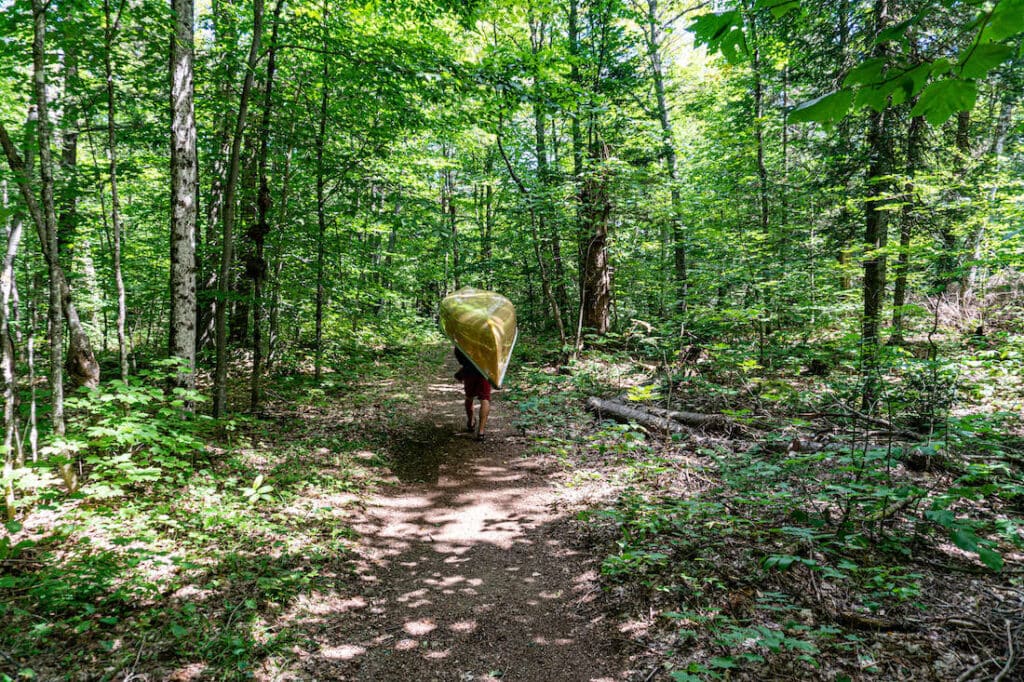
Boundary Waters Route Options
My favorite BWCA route is starting off at the Gunflint Trail at Saganaga Lake and canoeing to Red Rock Lake, Alpine Lake, and Sea Gull Lake to loop back to the start.
There are lots of different route options, though, and you can’t go wrong using the Trip Planner from the Friends of the Boundary Waters Wilderness (more on them later) to cater the route to your trip. You can choose different routes depending on your timeframe, how many portages you’d like to take, how long you want to paddle each day, and your current skill level.
Boundary Waters canoe rentals & Outfitters
While some people bring their own canoes to the BWCA, there are plenty of Boundary Waters canoe rental outfitters in both Ely and the Gunflint Trail. Not only are they inexpensive, but the guides here are a wealth of knowledge for planning your trip, asking questions, and getting some great beta on the best swimming spots and fishing holes. I’ve had great experiences with Voyageur Canoe Outfitters .
Keep in mind that the BWCA is a very large wilderness area, and with so many lakes and islands, you could spend a lifetime exploring different routes. No matter if you choose Ely or Gunflint as your Boundary Waters entry point, you’re going to have a blast.
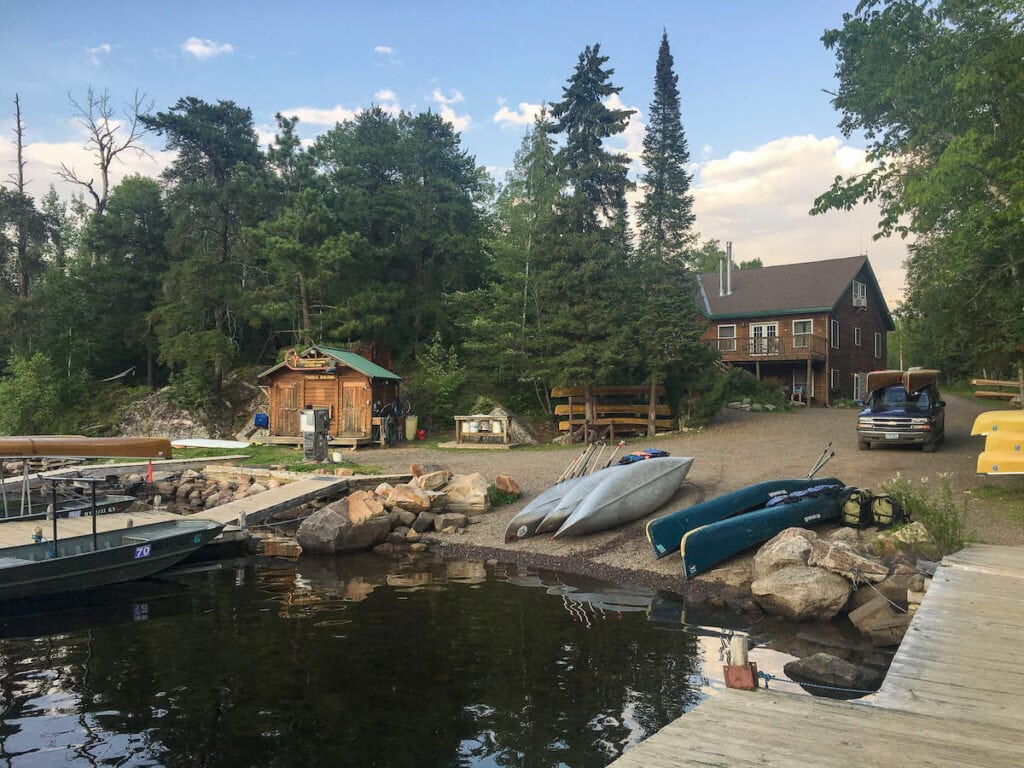
BWCA Permits
Once you’ve decided on where you want to start your trip, you’ll have to secure a BWCA permit. Permits are required for overnight trips from May 1 to September 30 . Walk-up permits are available the day of and the day before your trip, but their availability is not guaranteed. Keep in mind you don’t need to know exactly how many days or how many people are in your party to reserve a permit.
One Boundary Waters permit allows a group of up to 9 people and 4 watercraft to enter the wilderness . You can’t exceed the group limit at any time on water or land. Fees are $16 per adult per trip ($8 per kid per trip), and there’s also a non-refundable $6 reservation fee.
If you plan on fishing, obtain your fishing license before your trip either online or at any gas station/bait shop across the state. If you’re a Minnesota resident, an annual fishing license is $25 or $14 for 72 hours. If you’re a non-resident, it’s $51 annually, $43 for 7 days, or $36 for 72 hours.
The reservation system for Boundary Waters permits opens up at 9 a.m. CT on the last Wednesday of January every year on the BWCA recreation.gov website . If you plan on canoeing outside of the May-September season, you do not need a permit. BWCA canoe rental businesses can also provide permits.
You’ll need to pick up your permits in person at either a Superior National Forest district office or a BWCA outfitter in order to complete the mandatory Leave No Trace & Tread Lightly education session. This is a relatively short video/Q&A session that ensures visitors understand how to minimize their impact in the backcountry and stay safe in the remote wilderness.
While you don’t need a permit to bring a dog into the BWCA, you should bring a current rabies certificate and rabies tag on their collar. Dogs are welcome in the wilderness if they have good voice control, don’t bark or chase wild animals, have experience in a canoe, and are not left unattended . Always be prepared to clean up after your dog.

Boundary Waters Campsites
Boundary Waters campsites are spread throughout the wilderness area and tend to be on wooded shorelines. It’s pretty obvious where most of them are, and they are clearly labeled on BWCA maps. An easy way to tell if a campsite is occupied or not is to look for canoes on the campground shoreline. You can only camp at existing campgrounds in the BWCA and the campgrounds are first-come, first-serve .
It’s a good idea to break camp early and snag the campsite you’d like by early afternoon so you get the one you want. I once slept in and paddled during the afternoon instead and found every campsite was already taken at the lake I had planned to stay on. That meant a much longer day of paddling for me since I had no choice but to canoe on to the next lake and find the next empty campground.
My main consideration when choosing a campground is the view. Do you want to be on a peninsula surrounded by water, in a thickly wooded area, or do you want to make sure you have a great view of the sunset? Take your priorities into account when choosing your spot.
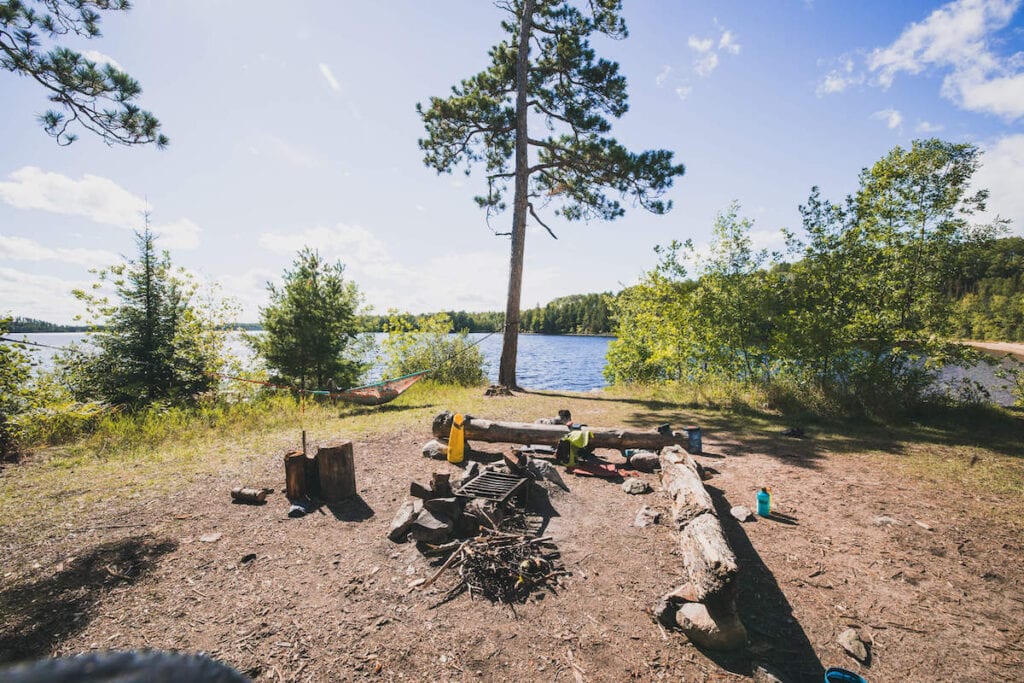
Boundary Waters Canoe Trip Gear
One of the best parts about canoe camping is that you only have to lug your gear on portages.
You can read our 3-day backpacking checklist to get a general idea of what you’ll need. It goes without saying that the Boundary Waters is a remote area; be sure to pack warm clothing and rain gear so you can stay safe in the event of storms, submerged and wet packs, or days or rainy weather.
Shoes for the BWCA
You’ll want good footwear for the Boundary Waters that can deal with water and rugged portages. I recommend water sandals whenever you’re in the canoe or getting in and out. Check our review of the Teva Universal Trail Sandal . These would be a great choice for a BWCA trip.
For portages, you’ll want hiking shoes or boots that have a closed-toe and closed-heel. These will keep your feet and ankles protected while carrying heavy packs and the canoe. Portages in the BWCA are filled with rocks, tree roots, and slippery mud so plan accordingly.
Dry Bags and Canoe Packs
While you can technically use a backpacking pack to carry your gear, using canoe packs from Duluth Pack, Frost River, or Granite Gear has its perks — it’s also what you’ll get from your outfitter if you rent a canoe. You can also invest in a few lightweight dry bags to keep your items dry and separated, like these Sea to Summit Lightweight Dry Sacks .
For a cheaper option, simply line your pack with a garbage bag and arrange your gear inside.
Navigating the Boundary Waters
You’ll need a compass, map, and map case (outfitters will provide these) for a Boundary Waters canoe trip. Fisher Maps , McKenzie , and Voyageur make the best BWCA maps or National Geographic also makes a detailed BWCA Map Pack . There’s little to no cell service in the BWCA, so don’t rely on your phone for navigation and pack or rent a satellite communication device for safety.
To navigate the Boundary Waters, your best bet is to orient yourself using portages, campgrounds, and prominent features of the shoreline like points, islands, bays, etc. It’s normal — and a right of passage — to get pretty confused about exactly where you are since the lakes and islands can make it seem like a maze. Don’t worry, it’s rare for visitors to actually get lost!
Water Gear & Equipment
Aluminum canoes are heavier to carry on portages, but they’ve got one big benefit: they’re bombproof. No need to worry about scraping a rock in these! Kevlar canoes are more fragile and require extra effort when using them, but they’re much lighter to use while paddling and portaging.
You’ll also need a fair amount of gear for your canoe (outfitters will provide all of this): paddles, life jackets , duct tape, sponge and bailer, and cords to tie in your packs. If you’re planning to fish, bring a pole and tackle box. And don’t forget a swimsuit!
Essential Clothing for Paddling
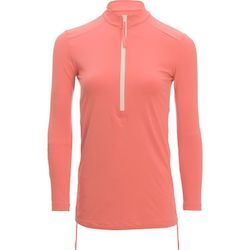
Carve Designs Cruz Rashguard
I prefer wearing a rashguard over sunscreen these days. I own the Cruz in 2 colors and it’s a staple for any water activity because it dries quickly but also keeps you cool, plus the cut is flattering.
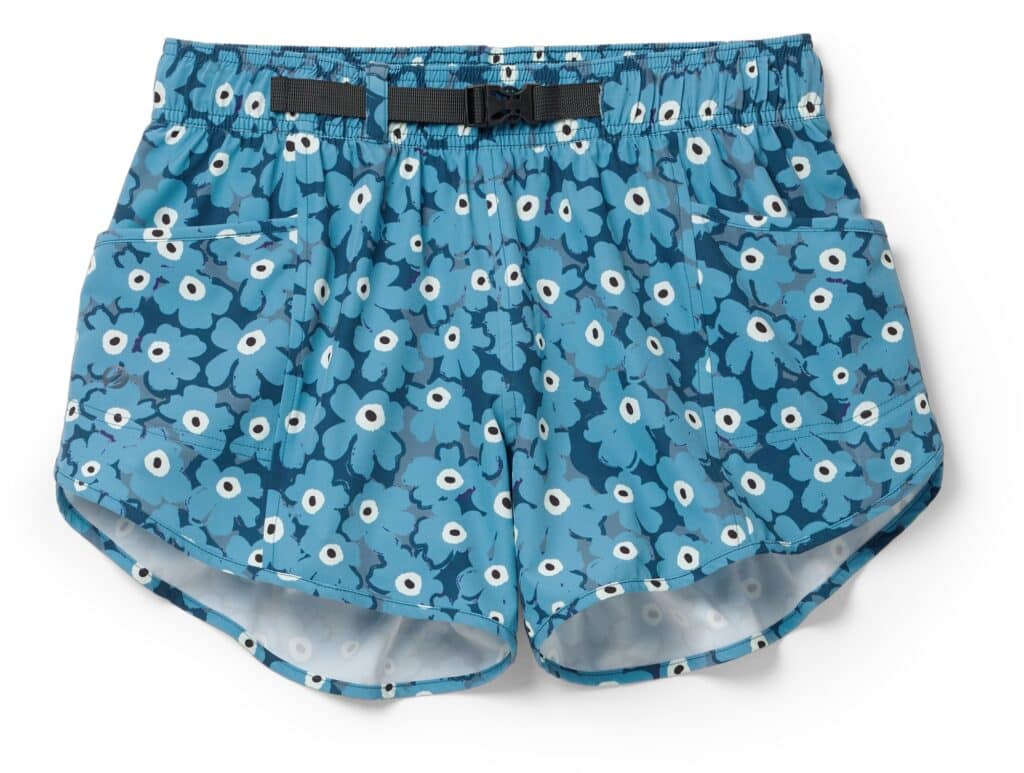
Nani Swimwear Hybrid Explorer Shorts
These shorts are super comfortable, dry really quickly, and come in a bunch of colors and prints. I wear them on all water adventures!

Teva Universal Trail Sandals
Sandals that stay on your feet and can get wet are essential. I like these because they have good grip and can be worn hiking as well, plus they can easily be strapped to your boat when not in use.

Outdoor Research Sunbriolet Hat
You’ll want a wide-brim hat that can get wet and has a chin strap so it stays on in the wind. This Outdoor Research hat is quick-drying, will float if it falls in the water, and comes in a variety of colors.
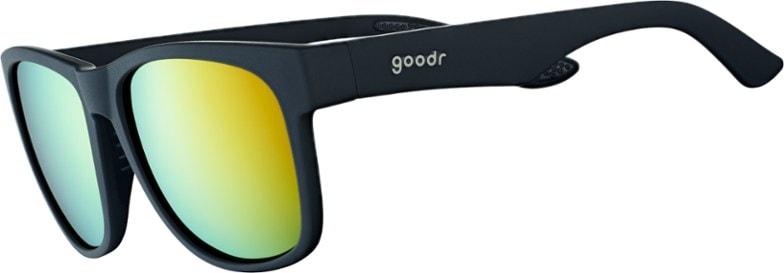
Goodr Polarized Sunglasses
Polarized glasses are best for the reflection of the water. I like to wear budget-friendly sunglasses paddling and I always wear a retainer so I don’t lose them in the water.
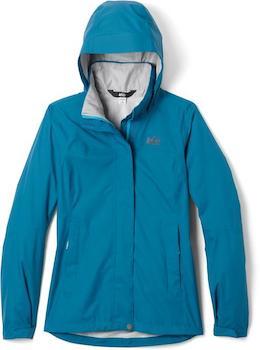
REI Co-op Rainier Rain Jacket
If it’s chilly or windy it can be helpful to have a lightweight rain jacket or windbreaker out on the water with you. I usually pack a jacket like this just in case!
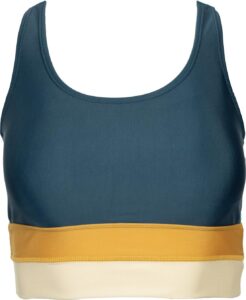
Supportive Swimsuit or Sports Bra
You’ll want a comfortable swimsuit that you can be active in. I like to avoid swimsuits that pull on my neck (like halters) and have been loving Nani Swimwear lately.
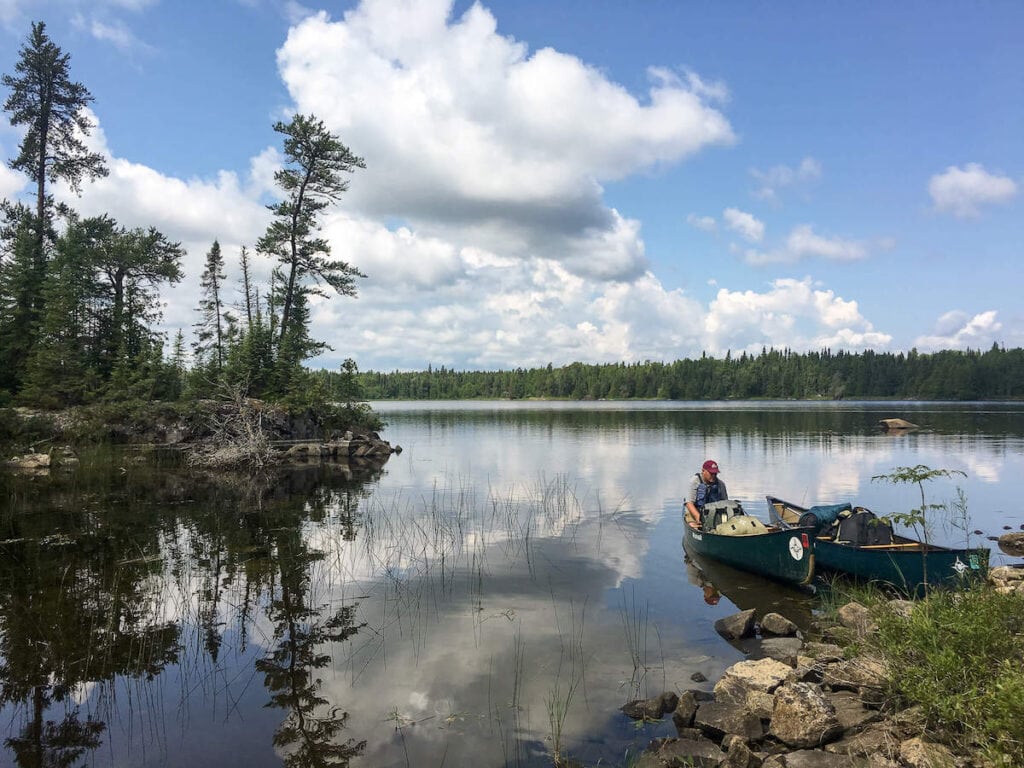
There are bears that live in the BWCA, but they rarely bother people. Most visitors opt to hang their food from a tree instead of bringing a bear canister. To hang your food bag, find a tree limb about 15-20 feet off the ground. Attach a heavy item to the end of your rope and throw it over the branch so that the rope is 4 feet away from the trunk. Now attach your bear sack to the rope, pulley your bag into the air, and tie off your rope. With a little searching, you can usually find a popular tree limb that’s used near each campground.
Water Filtration
Luckily, obtaining water in the Boundary Waters is much easier than most backpacking trips. While old-timers may still drink straight from the lake, it’s safer if you boil or filter the water. Simply paddle out away from your campsite and fill your containers from the lake, then purify or boil the water before using. While I used to drink straight from the lake, it’s not worth risking a Giardia infection.
The Platypus GravityWorks filter system is simple to use without needing to pump it. I’ve also used a Katadyn Hiker Microfilter in the BWCA, too, which I like because you can filter water straight into your water bottle while you’re canoeing.
I recommend filling and treating a 1- to 3-gallon water container when you arrive at your campsite to use for dinner, breakfast, and filling smaller 1-liter Nalgenes for the next day’s paddle.
Fire, Camp Stoves, and Cooking Gear
BWCA campgrounds have a fire pit area that can be used for cooking as long as there isn’t a fire ban in the area. The fires must be small and be put out completely when you’re not in camp. Firewood is available from the surrounding forest, but remember to only take dead and downed wood — live wood doesn’t burn well, anyway. If there is a fire ban, bring a camp stove for your cooking.
Sun Protection
It’s easy to get sunburned on a Boundary Waters canoe trip. Not only are you spending a lot of time out under the sun, but it’s also reflecting upward from your canoe and the water, too! Use sunscreen , a sun hat , and consider UPF clothing to keep the sun at bay.
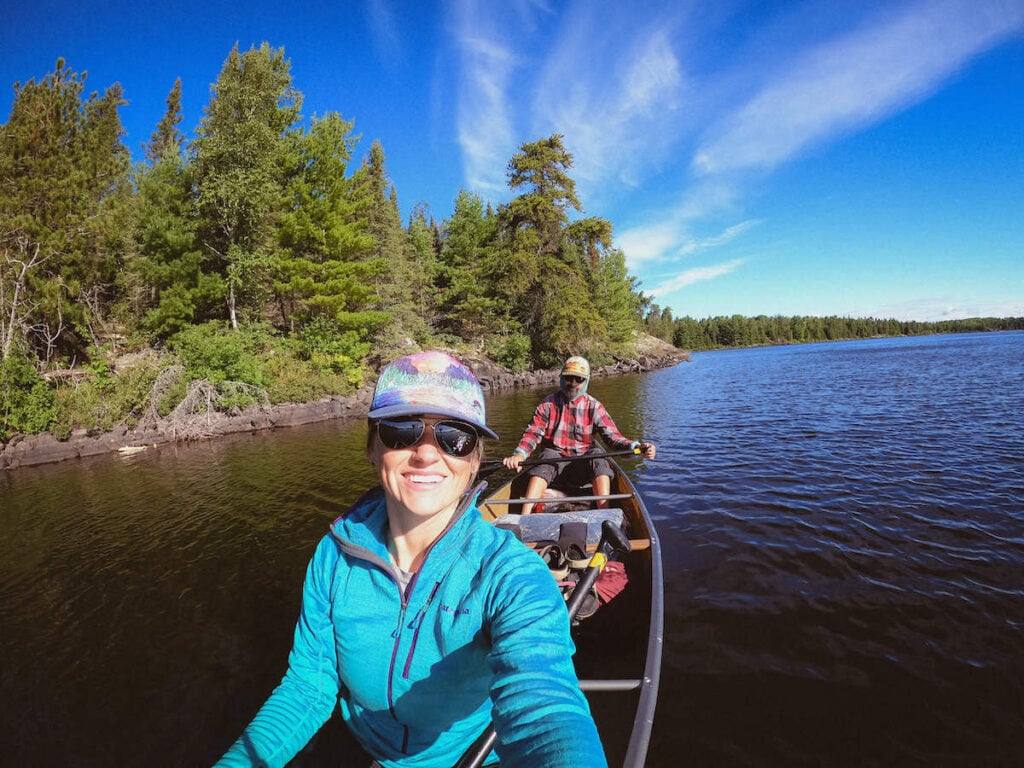
Help Protect the Boundary Waters
The BWCA is a unique, special place. But that doesn’t mean it always will be. Consider supporting the Friends of the Boundary Waters Wilderness to ensure this national treasure stays protected. Proposed copper-sulfide mines like Twin Metals risk contaminating and permanently polluting the Boundary Waters.
Learn more about threats to the BWCA and how you can help protect it by supporting Friends of the Boundary Waters Wilderness .
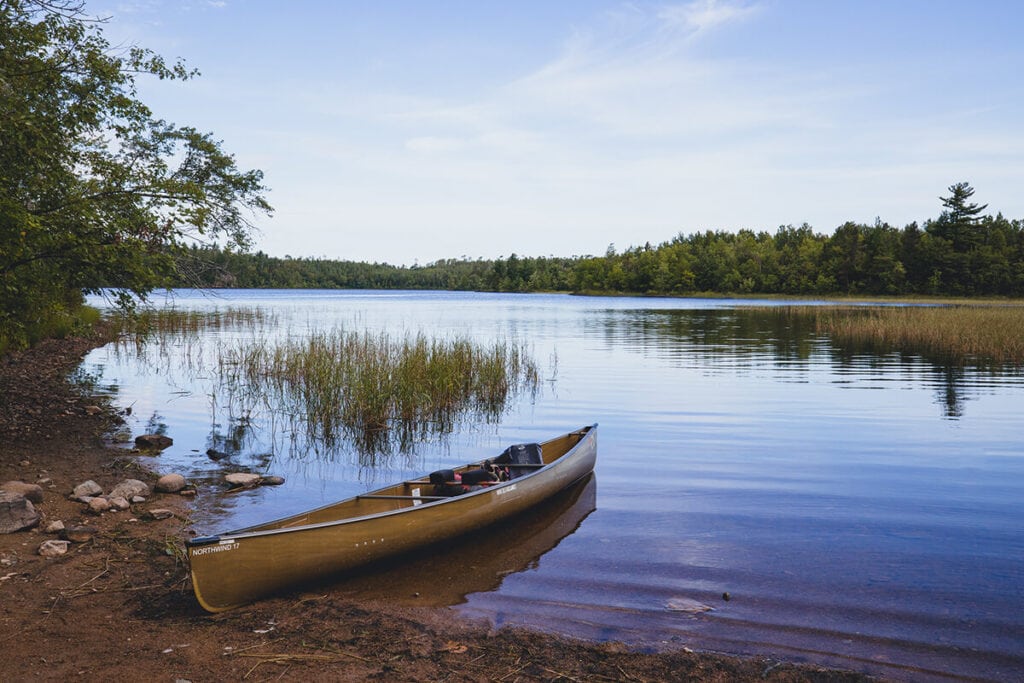
Taking a canoe trip through Minnesota’s Boundary Waters is a trip unlike any other, and thanks to its massive size and undeveloped character, it’s a wilderness you can return to again and again for new adventures. Whether you’re a seasoned paddler or new to canoe camping, the BWCA will not disappoint!
Have you done a Boundary Waters canoe trip or are you planning one? What questions do you still have? Let us know in the comments!
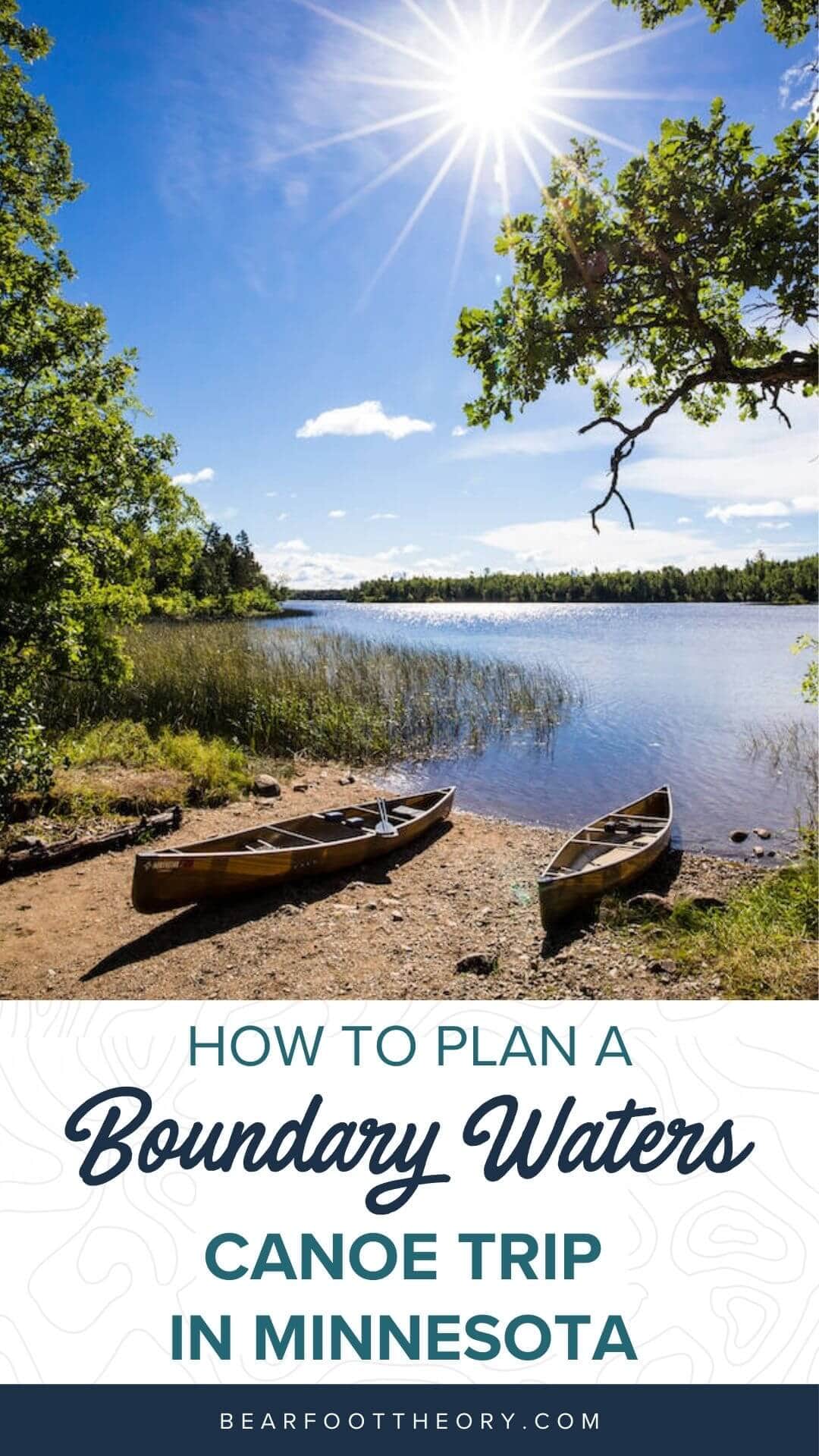
Isak is an outdoor freelance writer that loves traveling through Western public lands in his self-converted van to hike, ski, and find the country’s best used bookstores and coffee shops. When he’s not writing or adventuring, Isak is working on Seek More Wilderness to provide outdoor goods that give back to the outdoors. You can view his writing clips at IsakKvam.com and follow his van adventures on Instagram.
Leave a Reply Cancel reply
Your email address will not be published. Required fields are marked *
Save my name, email, and website in this browser for the next time I comment.
I just got back from the Boundary Waters (6 days, 5 nights in early-mid Sept) and it was amazing. I’m definitely making a trip back sometime, even though I had moments of questioning if i signed up for type 2 fun…. 1) drizzle to rain to soaked tent on night #2, 2) deluge welcomed us to a steep, rocky, slippery campsite, 3) trying to carry a canoe (even part way) on a mile long, level 8.5 portage (and then to find out that was only the second portage of a 3x portage day)…. but then we rewarded with the most beautiful rainbows, silence, starry nights, and disconnection from civilization. Great write up!
That sounds like an adventure!
Amazing clicks of pictures! we have done with same place and its look like a heaven on the earth and we enjoyed our trip. Before visiting this place, we consult with Boundary Waters Catalog about the place and we bought some tools from them. We got some information from some blogs and our trip was amazing.
Hi Eric, thanks for reading & the tip for the Boundary Waters Catalog. Glad you had an awesome trip!

Boundary Waters for Beginners: A Guide to the Incredible Wilderness
- Julie Singh
- March-27-2023
Beginners Guide to the Incredible Boundary Waters Wilderness
Make just one trip to the Boundary Waters Canoe Area Wilderness, and your life will be changed forever.
This pristine wilderness extends along 150 miles of the US/Canada border in Northern Minnesota and looks much the same as it did in the early 1900s when preservation efforts began. More than 1,000 lakes and hundreds of miles of rivers and streams make it a one-of-a-kind destination for canoeing , with 20% of the total area made up of water.
With thousands of miles of canoe and portage trails, the BWCA offers an adventure for all. Whether you desire a challenging trip paddling dozens of lakes and rivers and taking in scenic waterfalls or a peaceful paddle to observe ancient pictographs, the BWCA has endless options.
In this guide for beginners, we share insight into how to plan a trip to the Boundary Waters as a beginner, the best time to visit Boundary Waters, the best Boundary Waters canoe area routes and entry points, and the ultimate kit list for your trip.
What is the Best Time to Go to the Boundary Waters?
If you’re planning on kayaking the Boundary Waters then it’s important to plan your trip at the right time of year. Traveling the wilderness brings with it a range of risks, and you want to ensure that weather conditions aren’t going to impact the safety or enjoyment of your trip.
Open water season in the Boundary Waters is between May and September. If you want to enter the area between these months you’ll need to make sure you have a permit, as this limits the number of visitors to the area and ensures that the environment isn’t damaged by human interference.
You can visit the BWCA outside of this peak season, but the waterways and lakes will be obstructed by ice and you will be traveling by cross-country ski or snowshoe rather than canoe. You still need a permit to enter in the off-season, you just don’t have to pay for one.
Visiting the Boundary Waters in May means that you’ll be one of the first people back into the area that year, which can be great for snagging a campsite before the summer visitors come, but also means that some portages may be difficult to traverse due to lack of use. In June, tourism starts to pick up in the area, although the water temperature can still be quite cold and mosquitos and black flies begin to gather.
The best time to visit Boundary Waters on a fishing trip is between June and August, as this is when the most fish will be active in the water and you’ll have the most luck at catching a range of species. This is also the warmest time of the year so camping and canoeing are more comfortable, although bugs are particularly common in July.
Many people consider August to be the best time of year for canoeing Boundary Waters as there are very few mosquitos, the weather is warmest and the water is also a great temperature for swimming. The wilderness sees the highest number of families during this month, so if you’re trying to visit when it’s quiet you may want to avoid the peak season.
By the time September comes around, the Boundary Waters becomes much quieter as the temperatures start to go down and Fall starts to draw in. If you’re not too bothered by chilly nights this is a fantastic time to visit. The remarkable leaf colors and the lack of mosquitos (and crowds) also make it one of our favorite times of year.
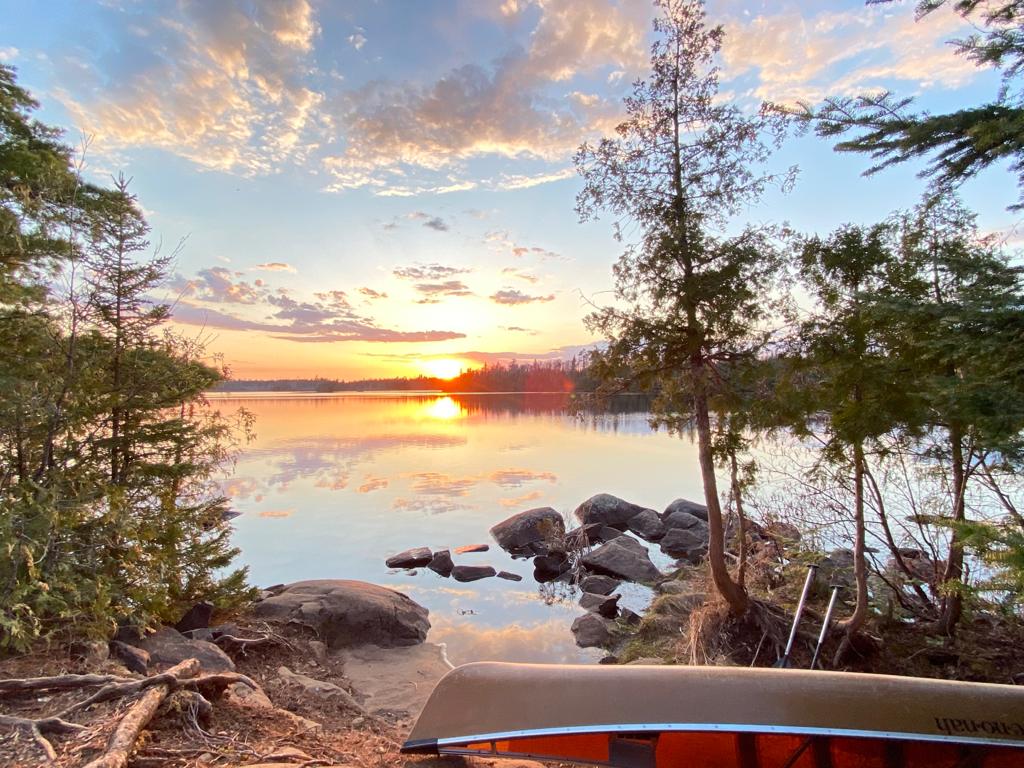
What is the Best Canoe for BWCA?
There are a variety of different brands of canoe available for adventurers wanting to explore the Boundary Waters, and the type you choose may depend on whether you’re renting a canoe from an outfitter for your trip or buying one for yourself. So instead of recommending specific brands, here’s what you need to consider when choosing the best canoe.
Firstly, while kayaks are considered to be very good watercrafts in general, canoes are typically a better choice for a Boundary Waters trip. Canoes are more stable and can carry more gear, and lightweight versions make carrying them over portages or removing them from the water much easier.
Some types of canoes are designed specifically for multi-day trips, so you’ll want to opt for one of these if possible when you’re planning your trip. You’ll be carrying your pack and gear in your canoe when you’re paddling the Boundary Waters, so you also need to consider how much storage space is available and whether this will be enough for your equipment.
Most Boundary Waters outfitters have Kevlar canoes in their fleet for BWCA trips. Kevlar canoes are lightweight and are easy to paddle and carry. Since a BWCA trip requires both paddling and portaging, Kevlar canoes are a great choice.
If you’re traveling with only one other person, you might decide that a double canoe is the best option so you can share the load of paddling. Paddling a canoe solo can be a bit more challenging, so splitting a group into pairs is best.
If you’re a beginner visiting Boundary Waters, it’s a good idea to speak to one of our recommended outfitters to discuss the best type of canoe for your trip.
Boundary Waters Canoe Area Permits
Boundary Waters permits are required all year, but there are a few factors that decide which permit you will need and how to get it.
If you are doing a canoe camping trip during the summer months, you will need an Overnight Paddle permit that allows you to paddle and camp overnight in the BWCA. Get an OP permit for your BWCA trip at Recreation.gov .
It helps to know where you will be renting a canoe or gear first, so you can choose the outfitter as the issuing station so they can issue the permit when you pick up your gear. Alternatively, the outfitter can also book the permit for you.
What are the Different Types of Boundary Waters Permits?
Depending on the time of year you visit and the type of trip you’re planning in Boundary Waters, there are several different types of permits on offer.
Between May 1st and September 30th
Overnight paddle (op).
This is the most popular permit (and way to explore) for the Boundary Waters trip. This is a permit for your typical canoe camping trip in the BWCA.
Day Use Only (no camping)
If you’re visiting BWCA for the day, you just need a Self Issued Permit which is available at the kiosks at the BWCA entry points and from Forest Service offices.
Hiking and Camping Overnight (no paddling)
If you want to stay in the Boundary Waters overnight, but won’t be paddling around, you need an Overnight Hiking Permit for the location you are entering. There is no limit for the number of nights you can stay in the area once you’ve entered.
After September 30th and before May 1st
In the off-season months between September and May, you only need a Self-Issued Permit to enter the Boundary Waters. These are available from kiosks at BWCA entry points and Forest Service offices. Reservations are not required and there are no recreation fees.
The Best Boundary Waters Entry Points
Boundary Waters entry points are all that stand between you and the chance to explore this phenomenal piece of wilderness. You must have a permit to pass through an entry point, but then once you’re in you can walk and paddle around as freely as you please, staying for any duration you’d like.
Boundary Waters permits need to be reserved in advance and operate on a first-come, first-served basis. Different entry points have different numbers of permits available each day, so you need to do your research in advance and ensure that you’ll be able to enter the BWCA when you arrive.
Here are some of the most popular Boundary Waters entry points in each area to inspire you.
#12 – Little Vermilion Lake
#16 – Moose River
#4 – Crab Lake
#22 – Mudro Lake
#24 – Fall Lake
#25 – Moose Lake
#30 – Lake One
Isabella Area
#34 – Island River
#75 – Little Isabella River
#41 – Brule Lake
Grand Marais Area
#54 – Seagull Lake
#55 – Saganaga Lake
5 of the Best Boundary Waters Routes
As well as choosing an entry point, you also need to plan your route for canoeing Boundary Waters. After deciding how many days you want to explore the area, or whether you’d just like to plan a day trip, take a look at some of the most popular routes below.
Sawbill Lake
If you’ve only got time for a day trip kayaking the Boundary Waters, Sawbill Lake is a great spot to explore. Paddle around the lake or portage to nearby Smoke Lake or Alton Lake and enjoy the rugged scenery in this secluded spot. The route is on the Tofte side of the BWCA, so if you’re renting equipment you’ll need an outfitter on this side of the area.
The Number Chain
This route is one of the best Boundary Waters for beginners options, as it focuses on minimum paddling and maximum enjoyment of the area. You begin at Lake One and then travel to Lake Two, then into Lake Three and then finish at Lake Four, with only a handful of portages and plenty of time to stop and swim or fish. This route starts on the Ely side of the Boundary Waters, so you’ll need to rent equipimtnet from near the town.
Seagull and Saganaga Lake
Right on the border between the USA and Canada in the Grand Marais area of the BWCA, this route lets you loop from Sea Gull Lake, up to Saganaga and then back down to your starting point. It’s a route with a lot of paddling and only a few portages, which is great for a weekend trip.
Kawishiwi River Triangle
A classic beginner’s route for Boundary Waters canoe trips is the Kawishiwi River Triangle, which has a small number of portages and usually takes about three days to complete. Starting on Farm Lake on the Ely side of the Boundary Waters, you enter the Kawishiwi River and paddle along the south section, around a triangular route to Clear Lake, then connect back to Farm Lake the way you came.
Fall Lake and Basswood Lake Loop
This route will take between three and five days depending on your fitness and experience, and takes you from the edge of Fall Lake, near Ely, around Basswood Lake, right on the edge of the USA/Canada border. You begin and end at entry point #24 ‘Fall Lake’ and is a great Boundary Waters route option if you don’t want to portage too much.
Staying at Boundary Waters Campsites
The Boundary Waters Canoe Area Wilderness offers over 2000 designated campsites across the 1200 miles of canoe routes and 1,100 lakes. When you’re planning how to camp in the Boundary Waters, the first thing to note is that these campsites are all backcountry first-come, first-served sites, and are not reserve-able.
While canoe camping in the BWCA, you must camp in these designated campsites. You can see the locations of each of these campsites on an official BWCA map .
All of the designated campsites in the Boundary Waters Canoe Area have a wilderness latrine (an open-pit toilet). The sites closest to the entry points into the BWCA can be busy, and the farther into the wilderness you paddle, the more solitude you will find.
If you are visiting the BWCA during the summer or holiday weekends, we suggest that you arrive at your campsite early in the day in order to secure a spot.
Boundary Waters Canoe Area campsites do have an unofficial rating system which ranks the sites between 1 – 5 stars. Check out BWCA.com for Boundary Waters Canoe Area campsite maps and campsite reviews and ratings.
A Boundary Waters Gear List
As the name explains, Boundary Waters is a Wilderness area, which means that there are very limited facilities for humans. Campsites are equipped with a fire grate and a latrine, but when it comes to what to bring to the Boundary Waters, you’ll need to pack everything else for yourself.
Packing as light as possible is definitely recommended, as you’ll have to carry all of your gear when you’re portaging. Some outfitters will be able to offer you pre-packed equipment kits, but the following list includes everything you need if you decide to bring all of your own items.
- A sleeping bag
- A sleeping mat
- A camp stove and fuel
- Cooking utensils
- Eating utensils
- A water bottle
- A water filter system
- Bear proof food storage system or food hanging system
- Garbage bags for waste
- A pocket knife or multi-tool
- A flashlight
- A navigation compass
- Toilet paper
- Hand sanitizer
- A first aid kit
- Personal hygiene products
- Weather appropriate clothing
- A rain jacket
- Wet shoes for canoeing
- Dry shoes for camping
- A sun hat or bandana
As well as the above items, you will obviously also need a canoe, paddles and a life jacket.
A space as vast as the Boundary Waters Canoe Area Wilderness can be daunting to travelers that have never explored it before. But the great news is that this beautiful part of the world is the ideal place to plan an outdoor adventure even if you are a beginner, with plenty of help and advice available from outfitters and regular visitors to the area.
If you’re thinking about a trip to the Boundary Waters, Trip Outside can help you find your ideal route with outfitters based in Ely and on the Superior shore in Tofte , and provide complete outfitting for your BWCA adventure.
Find more adventures in the state of Minnesota like kayaking the Mississippi River in Minneapolis. For more inspiration on Minnesota adventures, check out local adventurers like Look About Lindsey.
SAVE THE BOUNDARY WATERS
The Boundary Waters Canoe Area Wilderness is threatened by sulfide-ore copper mining. The Campaign to Save the Boundary Waters is leading the effort to ensure permanent protection for the Boundary Waters Wilderness, America’s most visited Wilderness and Minnesota’s crown jewel, from proposed sulfide-ore copper mining.
What would a Twin Metals mine on the edge of the Boundary Waters mean? Pollution. Not this mine. Not this place. #SavetheBWCA
Find out more about how you can help Save the BWCA!
No matter where you camp and canoe, make sure you follow Leave No Trace principles , and recreate responsibly outdoors to ensure our wilderness areas stay pristine for generations to come.
Meet Julie & Reet

We’re Julie & Reet, the outdoor adventurers behind TripOutside. We love human-powered outdoor adventures and have traveled to hundreds of destinations that you see on TripOutside. Read more..
Share this article
Why Trust Us?
We fully understand how tough it is to find trustworthy travel advice, and that’s one of the main reasons we built TripOutside. We live for outdoor adventure, and we take these blogs and content very seriously. Here are some of the reasons you can trust us:
We only work with the highest-rated outfitters in the industry.
We’ve traveled to hundreds of destinations that you see on TripOutside in our RV over 6 years and want to share the places that we love with you.
We don’t distract you with any ads and never sell your personal information, ever.
We are a small, self-funded team and only grow with your support. You can support us by booking your next outdoor adventure on TripOutside.
We want to help you get outside. Please share your feedback with us on how we can help make TripOutside work for you!
Related Post

North Wash Canyoneering Trip in the Irish Canyons
We recently took a full-day North Wash Canyoneering trip to the Irish Canyons near Hanskville, Utah ..
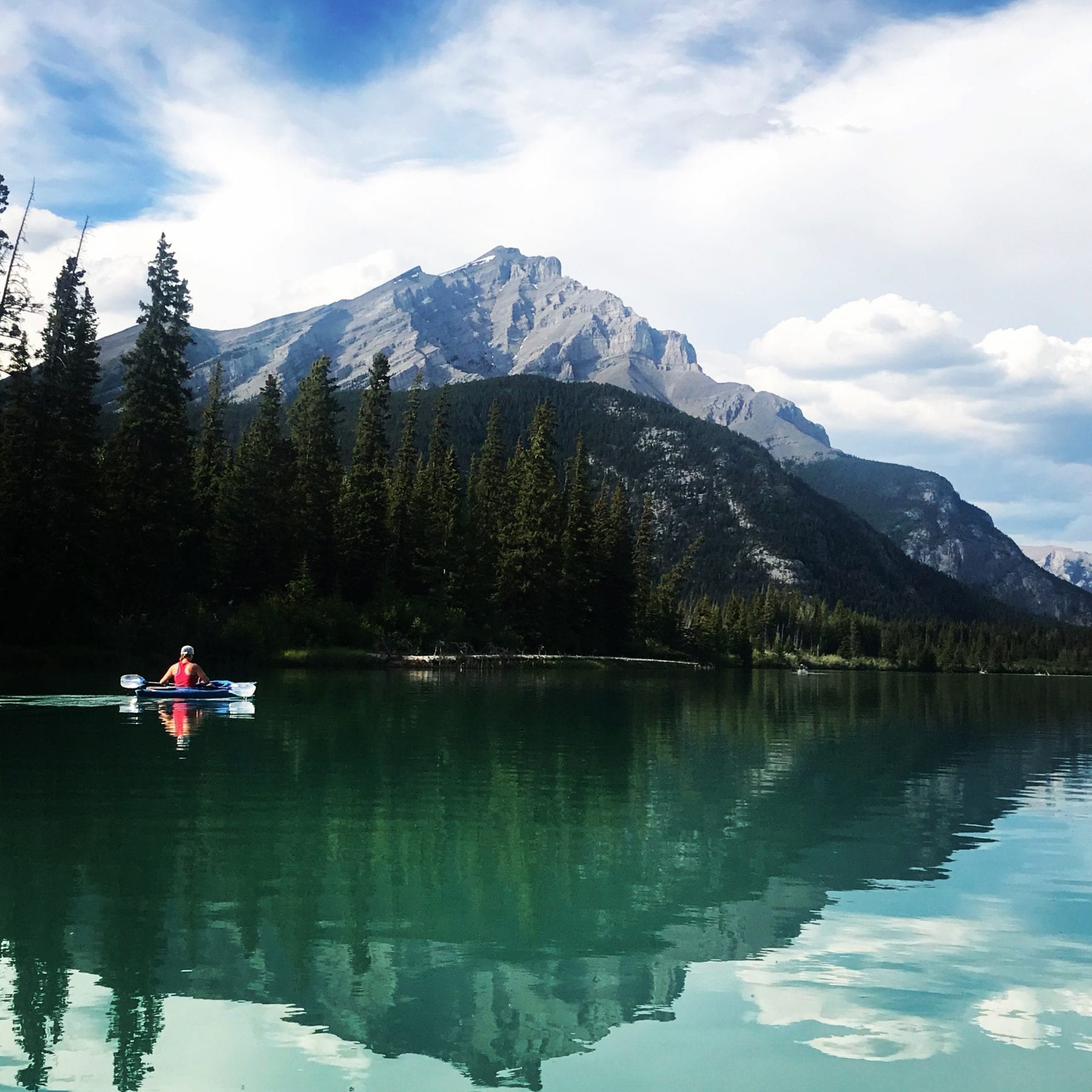
Kayaking for Beginners – Ultimate Guide
Ultimate Guide to Kayaking - Gear, Clothing & Destinations Guide Think kayaking is just for the ..

Outdoor Enthusiast’s Guide to Door County: 3-Day Adventure Itinerary
Exploring the Picturesque Peninsula and Outdoor Adventures of Door County Welcome to Door ..
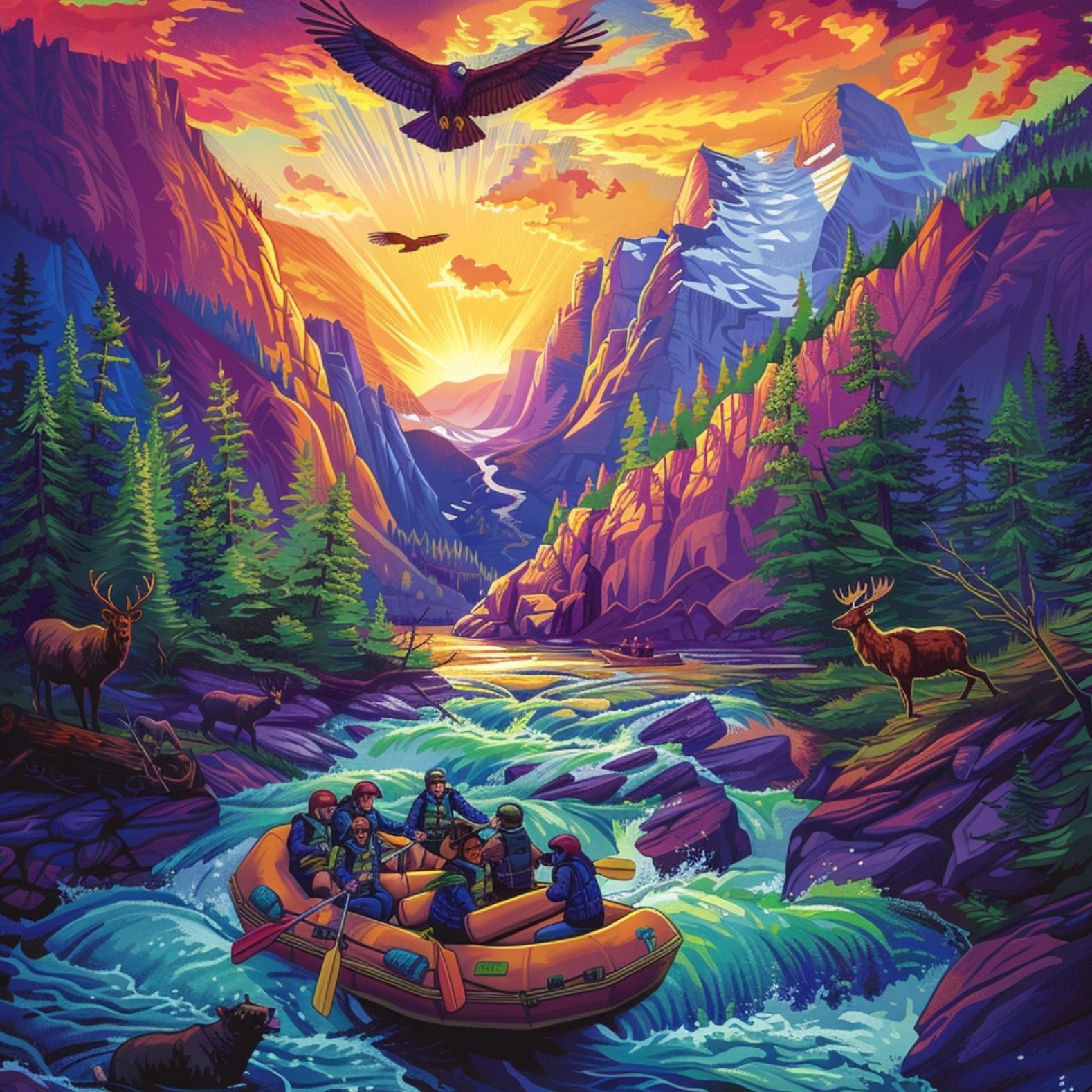
8 Best Places for White Water Rafting in Colorado
Top Colorado Rafting Destinations From Wild to Mild The Rocky Mountain snowpack we skied this wi ..

Beginner’s Guide to White Water Rafting
Beginner White Water Rafting - From the Rafting Experts Thinking about trying out whitewater raf ..
Discover 5,000+ handpicked human powered adventures.
Book directly with vetted local experts.
Average 4.8 ⭐️ across 185,000 reviews.
Every booking contributes to conservation.
Proud member of The Conservation Alliance and Leave No Trace.

Copyright © 2024 TripOutside
Subscribe To Our Newsletter
Search Outdoor Activities
Add Your Business
Outfitter Resources
Partnerships
Privacy Policy
Terms and Conditions

- Skip to main content
- Skip to primary sidebar

Wilderness Inquiry
Share the adventure!

We're happy to answer any questions you have!
- Name * First Last
- Comment or Question(s)? *
- Subscribe to News and Updates
- Are you a robot?
- Comments This field is for validation purposes and should be left unchanged.
Boundary Waters Canoe Area
Paddle million-acre wilderness.
The Boundary Waters Canoe Area Wilderness is America’s premier canoe destination. It is also one of the most accessible wilderness areas in the United States, and where Wilderness Inquiry began operating in the 1970s. Over one million acres in size, the Boundary Waters covers much of the Superior National Forest in northeastern Minnesota. Paddle among towering pines in the home of moose, lynx, wolves, and bald eagles.
Every Wilderness Inquiry trip ensures your adventure is the best it can be. Decades of experience in combination with top notch food and gear make Wilderness Inquiry BWCA trips an exceptional value. Our classic 5-day Boundary Waters Canoe Area Paddle Adventure is the quintessential guided canoe trip . Paddle lightweight Wenonah kevlar canoes and camp in beautiful lakeside campsites. The Boundary Waters lodge based adventure is based out of stunning Wintergreen Lodge on White Iron Lake. From here, you’ll enjoy excellent BWCA day trips off the Kawishiwi River or the Fernberg Trail, returning to delicious meals, a glass of wine, and a comfortable bed at night. The Boundary Waters Family Canoe and Hike trip is geared for families and based at a Forest Service campsite, allowing us to do day trips in smaller groups into the Wilderness. Our Boundary Waters Winter Adventure changes it up for winter fun at Camp Menogyn on West Bearskin Lake. You will love dogsledding, skiing, and seeing the Wilderness dressed in its winter clothes.
Whatever Boundary Waters trip you choose, we know you will enjoy this iconic wilderness area and come to understand why it is beloved by so many.
View by Itinerary
View by date.
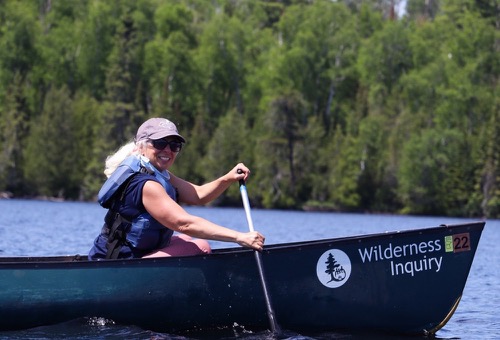

Boundary Waters Canoe Area Paddle Adventure
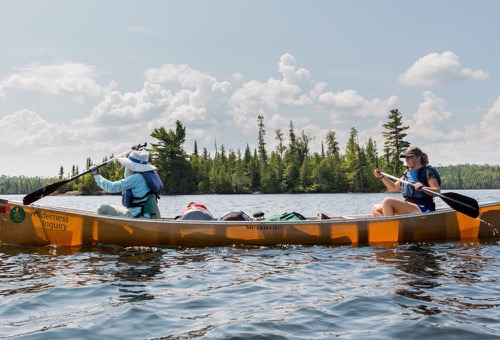
Boundary Waters Base Camp Adventure
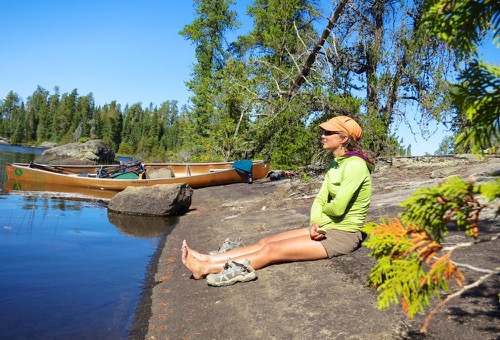
Boundary Waters Canoe Area Expedition
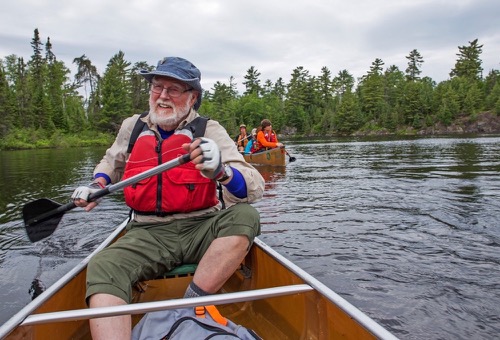
Boundary Waters Lodge-Based Adventure
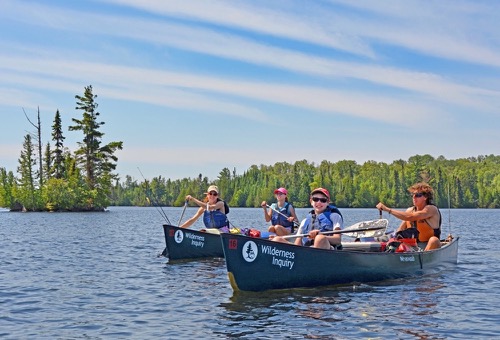
Boundary Waters Family Canoe and Hike
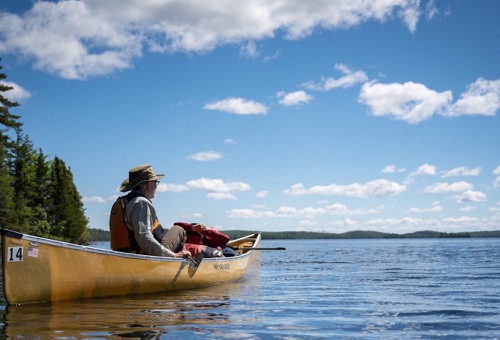
Boundary Waters Lodge-Based Reader’s Retreat with William Kent Krueger
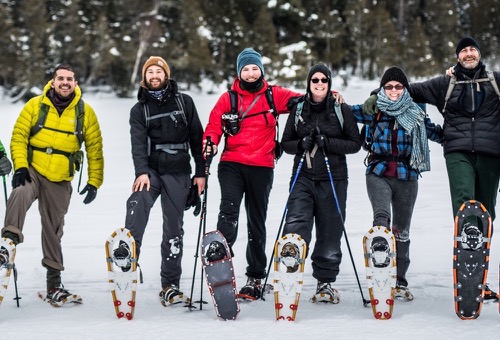
Boundary Waters Winter Adventure
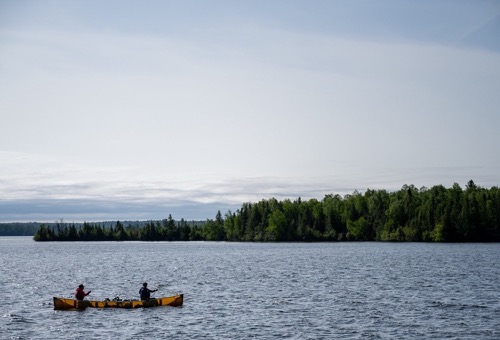
Boundary Waters Base Camp: Potlikker and Smoke with Chef Lachelle
About the area.
In 1964, Congress designated the BWCA as one of the first federally protected wilderness areas in the United States as part of the National Wilderness Preservation System. The BWCA, the northern third of Superior National Forest, lies on the international border between northern Minnesota and the Province of Ontario, Canada. Together, with the adjoining 1.2 million-acre Quetico Provincial Park on the Ontario side of the border, this international wilderness complex forms an unparalleled lakeland complex of 2.3 million acres, an area larger than Yellowstone.
Sculpted by glaciation, the area is part of the Canadian Shield, a geological formation that comprises portions of the earth’s most ancient exposed rock, some of which is 3 billion years old! The Boundary Waters contains about 1,175 lakes in all, creating a maze of interconnected wilderness waterways to explore. Whether you paddle one of the larger border lakes – Saganaga, Knife, Basswood, Crooked, Lac La Croix – or one of the smaller more intimate lakes, you’ll experience an undeveloped wilderness that appears much the same as it has for hundreds of years. Each lake brings its own distinct personality and you may find you and your canoeing partners each have a different favorite.
Two types of forests, the Boreal and Laurentian forests, converge to create a unique ecosystem with diverse plant and animal life in the Boundary Waters. Animals that would not normally be seen together, such as the white-tailed deer and the moose, have made the BWCA their homes. Many birds, such as bald eagles & loons, and over 20 species of wood warblers, use the Boundary Waters as their nesting grounds. Anglers can test their skills against the area’s lake trout, walleye, northern pike, or small and largemouth bass.
Humans have left their mark on the Boundary Waters as well. Native peoples inhabited the Boundary Waters area for thousands of years, with some human relics dating back to 10,000 BC. The Anishinabe (sometimes called Ojibwe, or Chippewa) and Dakota (Sioux) used the intricate waterways of the BWCA for hundreds of years. Native peoples first used many of the campsites and portages (paths between lakes) still used today. Artifacts from that period can still be found on occasion. European fur traders and missionaries first came into the area in the early 1700s. A working relationship developed between the European fur traders and the Ojibwe, based on trade of European goods for native knowledge and furs. This partnership ended in the mid 19th century due to the declining interest in furs as fashion.
Fur trading and logging of the Boundary Waters began taking its toll on the fragile ecosystem. People decided to act, setting aside this pristine area and working to protect it from further harm. In 1909, President Teddy Roosevelt established the Superior National Forest, with 1,000 square miles of roadless land (the precursor to the BWCA) later set aside in 1926 as the nation’s second administratively-established wilderness. The 1964 Wilderness Act designated the Boundary Waters as an original unit of the National Wilderness Preservation System, but with some compromises that allowed logging and motorboats to continue there. Congress passed additional protections for the BWCA in 1978, and expanded the area to its current borders and size of 1.1 million acres. The controversy surrounding this Congressional effort for the Boundary Waters also led to the establishment of Wilderness Inquiry; WI began by taking canoe trips in the BWCA and continues doing so to this day.
The Boundary Waters is one of National Geographic Traveler magazine’s “50 Places of a Lifetime.” Situated within Superior National Forest in northeastern Minnesota, the Boundary Waters Canoe Area Wilderness is a vast preserve of lakes and woods that stretches for about 100 miles along the U.S. border with Canada. Spread within the Boundary Waters are over 1,500 miles of canoe routes over more than 1,000 lakes, rivers and streams linked by trails called “portages.”
Due to strict permitting and non-motorized status the wilderness is yours to explore without people or vehicles. These factors contribute to the serenity of the area creating the perfect location for canoeing.
Camping for families
The wilderness is and ideal setting for families. Without the noise of daily life expect to learn more about yourselves and each other. The Boundary Waters Family Canoe and Hike trip is geared for families and based at a Forest Service campsite, allowing us to do day trips in smaller groups into the Wilderness.
Adventurers
Our classic 5-day Boundary Waters Canoe Area Paddle Adventure is the quintessential guided canoe trip for adventurers of all ability levels. Our experienced guides will teach you basic paddle strokes, the art of portaging a canoe, and can help you find a new appreciation for the great Northwoods.
Prove It First: Commonsense Protection For The Boundary Waters & Lake Superior. Take Action
Planning your trip to the Boundary Waters (A Step-by-Step Guide)
February 12, 2020 Recreation
I want to go to the Boundary Waters, but where do I begin?
That’s a question we hear a lot. If you’ve never planned your own trip, knowing which levers to pull to get the gears in motion can be daunting. It doesn’t have to be! Planning a trip into the BWCA should be fun, not overwhelming.
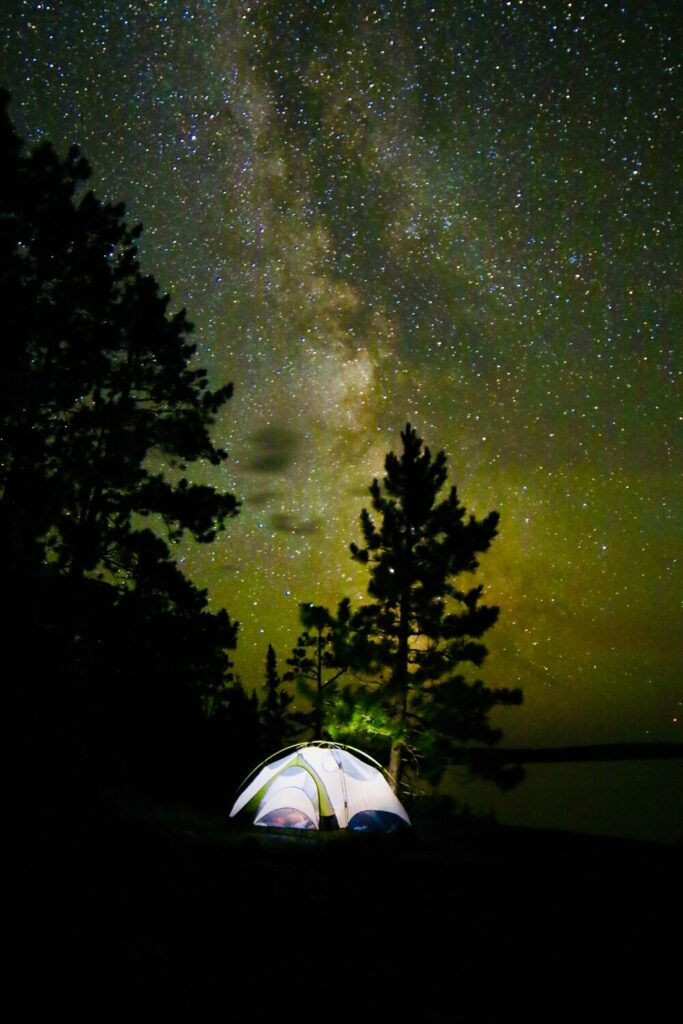
We went ahead and broke down the components of the trip-planning process and put it into an easy-to-follow timeline.
This isn’t a one-size-fits-all timeline; think of it as an overview, a handy guide that can be adapted to various situation, whether you get started planning months in advance, or if you get a permit a couple weeks before your trip is to start.
That being said, we built this timeline with the assumption that you and your party will be traveling during “the season,” from May 1 to September 30, when you are required to have an overnight camping permit.
Let’s begin here, with securing a permit and making sure you get to go to the place you want to explore.
January: Decide on an entry point and reserve your permit
Yes, this is early, and for procrastinators and those who like to fly by the seat of their pants, pack the car one night, and be out on the water the next, planning this far in advance may be well near impossible.
But, if there is a specific route you want to paddle , a specific area you want to explore, or you just want the peace of mind of taking care of the permit side of things, you better start early.
Reservations for BWCA permits open on January 29, 2020. To ensure you’ll be able to get in at your preferred entry point, on your preferred days, you should be ready to reserve your permit on the first day they are available.
Before you do this, you’ll need to get together with your friends and paddling partners (bring your maps) and decide on an entry point and a start date. You don’t have to have your entire crew formed (maybe your cousin Larry is still waffling. That’s okay. For now). As long as you have a core group of one or two other people, you’ll be set. The details of your route, such as where you will go from the entry point and for how long, can be worked out later.
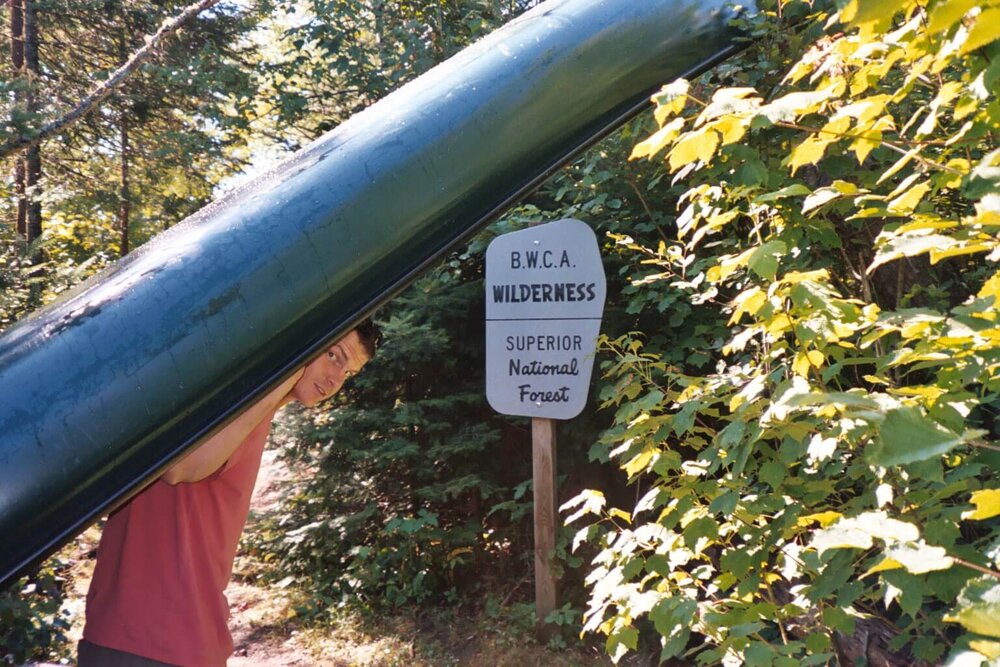
The important thing is to be ready to reserve your permit early (have you marked January 29 on your calendar yet?). While it’s more than possible to get an overnight paddling permit even a week before a trip, that’s a big maybe. As time goes on and others snatch up permits, the pickings will be slim.
There’s another, equally good reason for securing your permit early: All too often, we hear about people “wanting” to do a Boundary Waters canoe trip , and for no reason besides the fact that it’s easy to let the time slip away, they end up not going. The sooner you and your crew can hammer down a date, clear your calendars, and get the time off from work, the better.
Three months before you leave
From the time you reserve your permit to the time you get the crew together for a meeting (which can be over the phone, by Skype, etc.), you may have gained a few crew members or had others drop out.
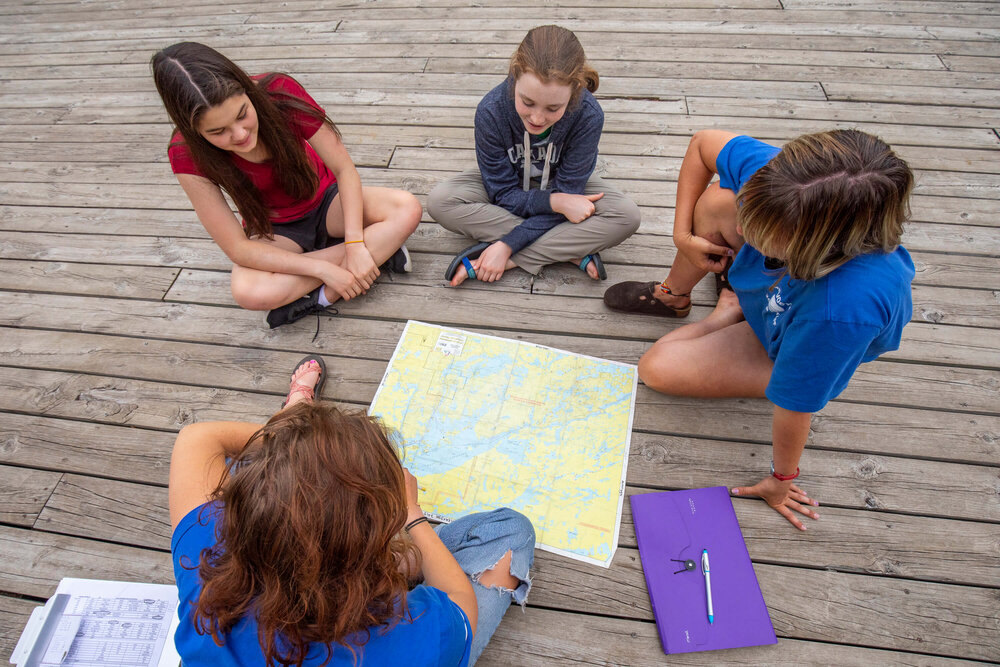
This first meeting, which should happen about three months before your trip, will cover some important ground. Here are a check list of things to go over:
- What is the purpose of the trip? There are many ways to enjoy the Boundary Waters . To make sure everyone gets the most out of the trip, it’s important to set expectations before you leave. Is the goal to cover a lot of ground? Is it to fish? Explore the geology of the area? To sleep in late and relax? Knowing this will help you decide on a route and do wonders for team dynamics.
- Hash out the route. How long will you be out? How many miles per day do you hope to travel? How many rest days should you schedule? Once you decide on your end date, everyone in the group must make sure they have that time available. One or two days after the meeting they should put in a request for time off, get an okay from their significant other, etc.
- Do you want to spend time in Ely or Grand Marais before or after the trip? Many people like to book accommodations in town and gorge on burgers and fries after a few days in the wilderness.
- Transportation. Who can drive? How much can their vehicle carry?
- Group gear. Take a look at the this gear checklist and figure out what group gear you will need, such as a tent, canoe, tarp, stove, packs, etc. Who in the group can provide this gear? If you need something, there are a number of outfitters surrounding the Boundary Waters who can rent the gear your crew needs.
- Make a plan to purchase needed gear and/ or contact outfitters about renting gear or canoes.
- Make sure that when it comes to renting group gear or purchasing group food that people save their receipts and that your party has an understanding about how expenses will be shared.
- Other things to discuss are: Experience levels of those who are going, if anyone has medical training, physical limitations, food allergies and other relevant concerns.
Two months before you leave
60 days before your trip, you should:
Decide on a menu and split up food-buying duties. Make one person responsible for buying all the breakfast food, another for lunch , and a third for dinner.
Make reservations for any gear you might need with the outfitter of your choice.
Book rooms in town (if needed) for both before and after your trip.
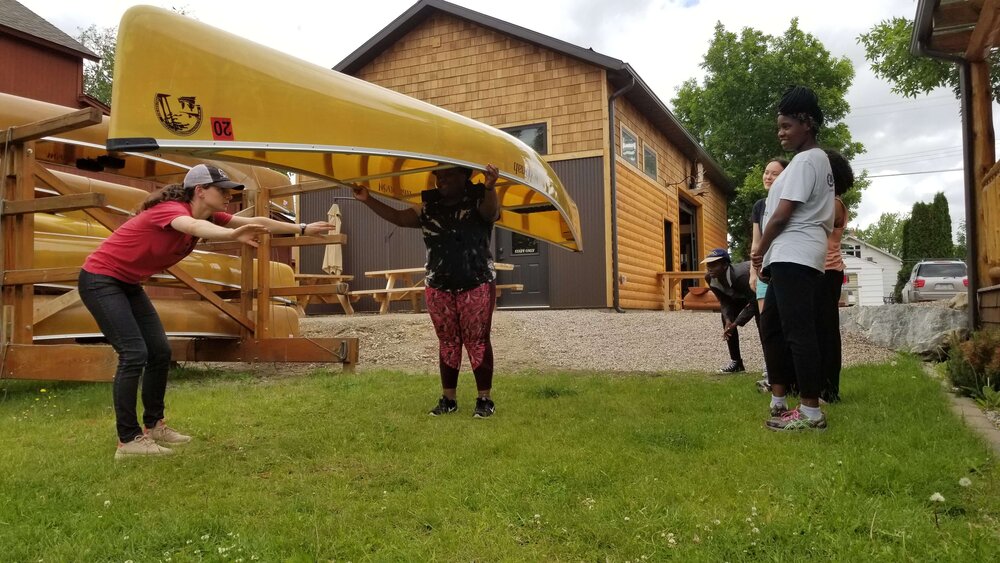
One month before you leave for the Boundary Waters
- Have all the non-perishable food packed and ready (perishable foods can wait)
- Have your route and itinerary written down and share it with family, friends.
- Load up contacts in your satellite communications device (SPOT or InReach, if you are bringing one) with the appropriate contacts
- Make an inventory of all your personal gear, and a list of everything you might need
- Have all your group accounted for. You either have it or have plans to get it.
Two weeks to go:
Make that last-minute shopping trip to pick up the bug net you can’t find, a spare pair of socks, or anything else you might need.
During the week before you leave…
- Get all the group gear and everyone’s personal gear together and do a final check. Do you have toilet paper? Matches?
- Purchase perishable foods (if you bring any) and have it ready to go the day you leave for the northland.
- Have your trail clothes that you will change into before hitting the water ready. It’s nice to drive up in some “civvies” and have them there to change into when you get off trail.
- Have the vehicle(s) gassed up and packed up the night before so you’re ready to go in the morning.
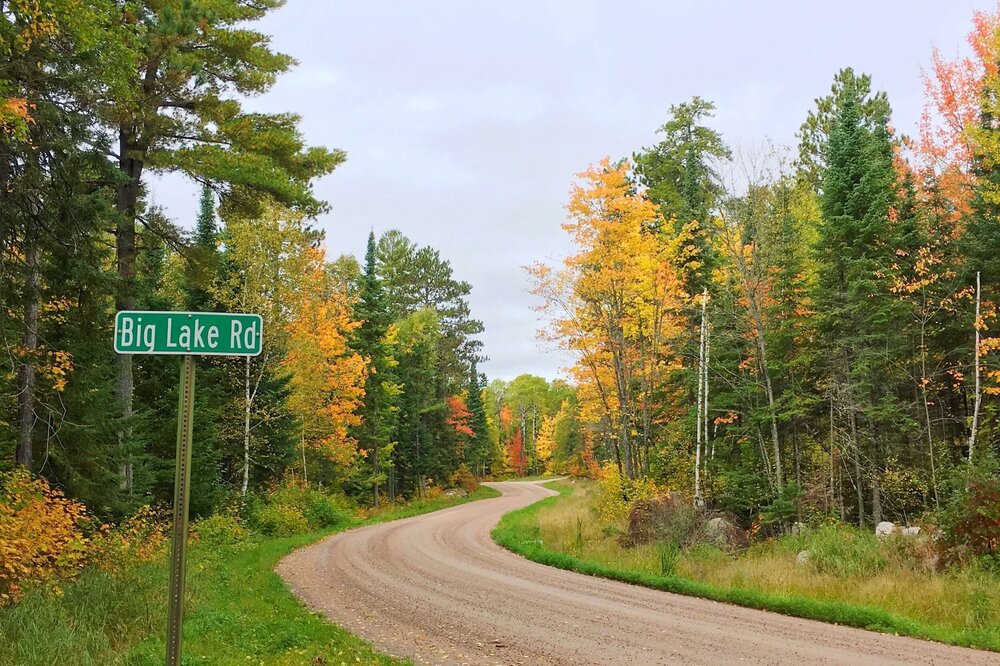
Like we said, this isn’t an absolute plan. People drop out at the last minute, friends pop up wanting to go, and some people like the crunch of planning and packing for a trip in three days.
However you do it, remember, there is a post-trip component as well.
This generally includes:
- A burger and a few beers
- The dreaded moment you check your emails
- Cleaning up all the gear
- Settling accounts (gas, etc.)
- Discussing where to paddle next year…or next month
Comments (0)
Do your part to protect the boundary waters, continue reading, new mountain biking opportunities in ely, minnesota.
Ely, Minnesota, boasts 9.4 miles of world-class mountain biking trails, attracting riders nationwide and boosting the town's outdoor economy.
Opening the Wild
A man who became paralyzed after an accident strives to create a wilderness resort for people with disabilities near the…
Fighting to protect clean water and the BWCA at the capitol
There has not been a legislative hearing on sulfide mining in over a decade. We're working to change that and…

How to Plan An Amazing Boundary Waters Trip in 6 Easy Steps

Last Updated: 4/12/23
The Ultimate Boundary Waters Trip Planning Guide
Boundary Waters trip planning doesn’t have to be daunting.
If you’re wondering how to plan your first-ever visit to the Boundary Waters Canoe Area Wilderness in northeastern Minnesota , I’m here to help. As a Boundary Waters outfitter on the Gunflint Trail , I’ve been helping people create unforgettable Boundary Waters trips for nearly two decades.
If you’re planning a Boundary Waters canoe trip but don’t know how to begin, read on. In this guide, I’ll do a deep dive into all your Boundary Waters trip planning questions. This guide breaks down Boundary Waters trip planning into five easy steps.
My insider advice will help you create a great first BWCA canoe trip. Just don’t be surprised if you end up falling in love; this region of the United States has captivated outdoor adventurers for centuries.
This post contains affiliate links. When you purchase something through these links, I receive a small commission that helps me create this blog’s content. There’s no extra cost to you.
Gotta run? Pin for future reference for Boundary Waters trip planning!

Ultimate Boundary Waters Trip Planning Guide Table of Contents
An Introduction to the Boundary Waters
- What Is the Boundary Waters Canoe Area Wilderness?
- Where Is The Boundary Waters Canoe Area Wilderness
- How the Boundary Waters Differs From A National Park
- When’s The Best Time to Go on a Boundary Waters trip?
- How the Boundary Waters Canoe Area Wilderness Permit System Works
- Why Should You Go on a Boundary Waters trip?
- Is A Boundary Waters Trip Right For You?
6 Steps of Boundary Waters Trip Planning
1) Select a date for your trip 2) Research your BWCAW entry point and plan your trip route 3) Book your permit 4) Organize your camping gear 5) Plan your camping menu 6) Mentally prepare for your Boundary Waters Trip
Helpful Boundary Waters Trip Planning Information
Best boundary waters trip planning resources, boundary waters trip planning mistakes to avoid.
- My Best Boundary Waters Trip Tips
An Introduction to the Boundary Waters Canoe Area Wilderness
What is the boundary waters.
The Boundary Waters Canoe Area Wilderness is a million-acre tract of public land stretching along northeastern Minnesota’s Canadian border. Nearly 1200 lakes populate the Boundary Waters. Portage trails connect these lakes into navigable canoe camping routes.
To move around the Boundary Waters, you load all your gear into a canoe, paddle across a lake or down a creek to a portage. At the portage, you pick up all your gear and canoe and carry it to the next lake. Rinse and repeat until you find a campsite (all equipped with a fire grate and latrine) that suits your group for the night.
You’ll often see people referring to the Boundary Waters as the BWCA, although the correct abbreviation is BWCAW. That “W,” signifying “wilderness,” is an important piece of the Boundary Waters’ identity.
Internationally acclaimed for its natural beauty, the Boundary Waters attracts anglers, canoeists, and those seeking a peaceful wilderness camping retreat. This tract of lakes and forest is a Minnesota must-see, but it’s not without unique challenges for even experienced outdoor adventure travelers.
Where is the Boundary Waters Canoe Area Wilderness?
The Boundary Waters Canoe Area Wilderness is located inside the Superior National Forest .
The Boundary Waters has three separate units:
- 1) The Vento Unit accessed from the east side of the Gunflint Trail and the end of the Arrowhead Trail in Hovland
- 2) The largest “main” section of the Boundary Waters that stretches from Gunflint Lake all the way to Ely and Crane Lake
- 3) The La Croix unit in between Burntside and Vermillion Lakes
In general, people access the Boundary Waters either from the east side via Lake Superior’s North Shore and Grand Marais or the west side via Ely and Echo Trail.
Drivetimes to Boundary Waters west side (Ely/Echo Trail)
Duluth to Boundary Waters west side: 2 hours Twin Cities to Boundary Waters west side: 4 hours Chicago to Boundary Waters west side: 9 hours
Drivetimes to Boundary Waters east side (Grand Marais/Gunflint Trail)
Duluth to Boundary Waters east side: 3 hours Twin Cities to Boundary Waters east side: 5 hours Chicago to Boundary Waters east side: 11 hours

The Boundary Waters are NOT a national park
Managed by the U.S. Forest Service , I think many people expect the Boundary Waters to be a slightly wilder national park. But this is no White Sands ; it’s a wilderness!
While the Forest Service maintains portages and campsites to keep them useable, they also let nature run its course. If a beaver dam floods a portage, you might get wet feet (and shins). Expect narrow, rock strewn portage trails sometimes impeded by down trees or thick brush. And yes, if a wildfire ignites somewhere in the BWCAW, you might have to adjust your route.
Beyond the iconic “Boundary Waters Canoe Area Wilderness” signs at the border to the wilderness area, there are no signs in the BWCAW. Boundary Waters visitors depend on their own navigation skills. With no cell service or a speedy way for first responders to reach distressed campers, BWCAW visitors should expect to get themselves out of any emergencies.

When’s The Best Time To Go on A Boundary Waters Trip?
While the Boundary Waters are open year-round, canoe trip season runs from when lakes start opening up in early to mid-May through mid October. Overnight camping permits are required from May 1 – September 30.
If you want to fish lake trout, go immediately after ice out or as late in September as possible. To avoid crowds, skip Boundary Waters high season in late July through late August. Wild berry season, the best summer weather, and ideal swimming temperature correlate with BWCAW high season.
Other considerations for when to take your Boundary Waters canoe trip: bugs like mosquitoes and black flies peak in June. Fall in the Boundary Waters is beautiful. Many people like the quietness of September trips, but days are short and temperatures can be chilly.
Like all things Boundary Waters related, you can have a fantastic trip no matter when you visit, but a little research ahead of time will let you know what to expect.

How The Boundary Waters Canoe Area Wilderness Permit System Works
To regulate usage, the U.S. Forest Service requires a permit for anyone camping overnight in the Boundary Waters between May 1 – September 30. (If you’re doing a Boundary Waters day trip , you still need a permit but they are free and self-issued.)
During the summer season, the Forest Service sets a number ( quota ) of how many overnight groups can enter the wilderness through each specific entry point each day. This helps eliminate overcrowding in especially popular Boundary Waters locations. It should also ensure that your group finds an open campsite within a normal day’s travel.
This quota system is critical to maintaining a wilderness feeling in Boundary Waters, but it’s also a little confusing.
Important Points About Boundary Waters Permits
- You only need one permit for your entire group (limited to nine people and four watercraft) for your entire trip.
- Your permit allows you to enter the BWCAW at a specific entry point on a specific day . As long as you enter the Boundary Waters on that day at that point, you can stay in the Boundary Waters as long as you want. (Technically you need to switch campsites every 14 days, but yes, some people have stayed for an entire year!)
- It’s worth reiterating that while a permit should mean there’s an open campsite group fairly close to the entry point, it in no way guarantees a campsite on the first lake you reach.
Why You Should Definitely Go on a Boundary Waters Trip
Many people come to experience great fishing for walleye, bass, pike, trout. Other Boundary Waters visitors want to see wildlife in their natural habitat. For most, disconnecting from technology and stripping life down to the bare essentials is the real draw. In 2023, the wilderness area was awarded “Quiet Park” status by Quiet Parks International.
In late July and early August, the Boundary Waters offer unparalleled wild berry picking and swimming. No matter why you choose to visit the Boundary Waters, you’ll be treated to unreal stargazing as well as beautiful sunrises and sunsets. In fact, in 2020, the International Dark Sky Association designated the Boundary Waters as the world’s largest dark sky sanctuary.
But beyond the region’s scenic, solitary appeal, Boundary Waters trips are often very personally rewarding. There’s no denying that BWCA canoe trips can be challenging . Many people walk away with increased self-confidence and the rewarding sense of “hey, I didn’t know I could do that!” Additionally, Boundary Waters trips can lead to meaningful connections with family and friends and memories you’ll never forget.
If you’re ready to get planning a BWCA adventure of your own, here are my 6 easy steps to plan an amazing Boundary Waters trip.
Is A Boundary Waters Trip Is Right For You?
But first, before committing to a BWCA canoe trip, carefully consider your answers to these five questions:
- Do you like being outdoors?
- Are you comfortable on self-guided adventure and do you trust yourself or someone else in your group with navigation?
- Do you like the idea of going off the grid?
- Do you have stamina and can you tolerate moderate physical discomfort?
- Are you okay with things not going to plan?
If you answered in the affirmative, a Boundary Waters trip might be right up your alley. Let’s get planning!

6 Easy Steps To Plan Your Next Boundary Waters Trip
1) select a date for your boundary waters canoe trip.
The date you start your Boundary Waters will have a profound impact on the nature of your canoe trip.
Since there’s nothing negotiable about the BWCAW overnight camping permit system. If you have a specific Boundary Waters route you want to do, you might need to be flexible with your starting date to accommodate permit availability. If you must start your trip on a specific date, you might not get your first choice of entry point. Should your schedule change and you need to start your trip on a different day, you must cancel your first permit and book a new permit for your new start date.
Remember, you aren’t booking a period of time in the Boundary Waters, you’re booking the right to enter the Boundary Waters at a certain point on a certain day. There is no such thing as entering the Boundary Waters a day earlier or later than what’s printed on your permit. If you don’t enter the Boundary Waters at the date and point on your permit, your permit is null and void.
Before you spend too much time gnashing your teeth over which Boundary Waters route you want to do, check the available Boundary Waters overnight paddle permits on recreation.gov to see which entry points and subsequent routes are available for your starting date.

2) Research Your BWCAW Route
Set aside a couple evenings to research the Boundary Waters before selecting your route.
(If you’re planning your Boundary Waters trip before permits become available in late January, you can do steps 1 and 2 simultaneously.)
With dozens of BWCA entry points to choose from it’s easy to feel overwhelmed. I highly recommend Robert Beymer’s Boundary Water Canoe Area guidebooks for a user-friendly introduction to the Boundary Waters. He discusses each entry point in detail and provides route suggestions for each entry point. It’s a great one-stop shopping resource to guide you to a route that’s the right length and difficulty for your group.
You can also find this information poking through bwca.com’s trip report archives or on the Boundary Waters reddit.
If you don’t like research (um, I’m not sure we can be friends . . .) your best bet for finding a route is to pick up the horn and call a Boundary Waters outfitters . These businesses on the edge of the BWCAW cater to the needs of Boundary Waters visitors with canoe and gear rental, shower facilities, bunkhouse accommodations, and yes, trip advice. Most outfitters’ websites list several canoe route suggestions and they’re happy to talk you through those routes. Often 15 minutes on the phone with an outfitter can save you two weeks of increasingly confusing (and conflicting) internet research.
How do you select a BWCA canoe route?
You need to answer one major question when selecting a Boundary Waters canoe route: what do you want to do on your trip ?
Specifically . . .
- Do you want to base camp a couple lakes in from your entry point?
- Is fishing important?
- Do you want to avoid portaging at all costs?
- How do you feel about big water (aka, large lakes)?
- Do you want to move every day?
The answers to these questions naturally narrow down route possibilities for your group. It’s important to prioritize because it’s rare, if not basically impossible, for a Boundary Waters route to perfectly align with all of your trip desires.
If you don’t want to portage, you’ll spend your Boundary Waters trip on a large, busy lake. If you don’t want to see many people, you’ll need to put a few difficult portages between you and the entry point. Beautiful scenery might come at the expense of great fishing. It’s all a give and take, so take the time to determine your Boundary Waters route dealbreakers before committing to an entry point.

3) Reserve Your Boundary Waters Permit
Permits for the upcoming season become reservable on the last Wednesday of January. That’s the first day you can reserve permits, but as long as there’s permit availability, you could buy a permit the very day you want to start your trip.
In recent years, the Boundary Waters have seen a surge in popularity. If you want a popular entry point during high season (late July – mid August) book your permit as soon as you can.
To book a permit, pop over to Recreation.gov . If you don’t have one already, you’ll need to set up an account. If you’re using a Boundary Waters outfitters for your trip, they can reserve the permit for you, but they will still need to set up a recreation.gov account specifically for you using your email address.
Avoid these Boundary Waters permit booking mistakes
If your group size is larger than one, be sure to list at least one alternate leader other than yourself. In the event that you’re unable to go on the trip, this allows the permit to be transferred to that alternate leader without having to cancel and book a new permit.
The exit date you put on your permit isn’t written in stone and has nothing to do with your permit validity. The Forest Service mostly wants this info for statistical reasons. Remember, you’re not reserving a “____” night trip in the Boundary Waters – you’re booking an entry permit.
You can adjust the amount of people on your permit up until the moment your permit is actually issued to you at a U.S. Forest Service office or a Boundary Waters cooperator station, like an outfitters.

4) Organize Your Camping Gear
If you backpack or car camp, you’re probably well on your way with owning the gear you need for a Boundary Waters canoe trip. Consult my Ultimate Boundary Waters Packing List if you’re not sure! A couple months out from your trip, use my packing list to determine any items you need to rent or borrow.
You won’t get very far on your canoe trip without a canoe . Really a canoe, some paddles, and lifejackets are the only specialized pieces of equipment you need for a Boundary Waters trip. Happily, more often than not, there’s a Boundary Waters outfitters no farther than ten miles from your entry point that can rent you a canoe for $35-60 a day depending on the type and model you select.
Portage packs vs. backpacks and why you need to use them for Boundary Waters trips
Another commonly rented piece of Boundary Waters specific equipment are portage packs. Often referred to as Duluth packs, these large bags hold all your equipment, personal items, and food as you travel over portages. They also fit well in canoes.
If you already own backpacking packs, those will work, although they won’t hold as much gear and depending on their size can’t always lie flat on the canoe bottom. If you want to purchase some portage packs before your trip, Cooke Custom Sewing makes our favorites. And remember, whatever style pack you use, you will need a heavy duty plastic liner (like a construction trash bag) for the pack to keep your gear dry.
When should I reserve gear for a Boundary Waters trips?
If you need a canoe, reserve one with an outfitter at least six weeks before your trip’s start date. For complete outfitting (where the outfitter provides everything -canoe, gear, food – except personal items like clothing and toiletries), reserve at least two months out.
Just need a tent or portage pack? A couple days’ heads up is usually plenty of notice.

5) Plan Your Camping Menu
Meal planning for a Boundary Waters canoe trip is a big task and really warrants its own post at a later date. (Stay tuned!)
To avoid packing way too much food, try delegating one person in your group to tackle this task. If you have anyone in your group with dietary restrictions, nominate them! For best results, start thinking about your Boundary Waters trip menu about a month out so you can order any specialized dehydrated food or have enough time to do your own dehydrating if that’s how you roll.
If you’ve gone on overnight backpacking trips, you’re probably already familiar with brands like Backpacker’s Pantry, Mountain House, or Good To-Go for lightweight, dehydrated entrees.
One beautiful thing about Boundary Waters trips is that you don’t have to solely depend on these pre-packaged meals. Because you only need to carry your food over portages, most Boundary Waters canoe trippers pack more fresh food (fruit, steaks for the first night dinner, breads like bagels) than you normally would on a backpacking trip.

6) Mentally prepare for your Boundary Waters trip
Attitude is EVERYTHING for a successful Boundary Waters canoe trip. I can’t overemphasize how important it is to go into a wilderness trip setting with an open mind and can-do attitude.
This might sound a little corny, but we see people struggle the most with their canoe trip when they fall into one of two camps. On one side we haven’t those who didn’t do any research about their trip and find it far more challenging than they expected. On the opposite end are those who researched their trip to the point that the trip can’t possibly live up to their expectations.
One technique for mentally preparing yourself for a great Boundary Waters trip is to have an answer to the question: “What will we do if it rains every day?” The people who have the most amazing Boundary Waters trip year after year are adaptable and go with the flow. No matter how diligently you research and prepare, things can still not go according to plan.
Boundary Waters Canoe Area: Western Region by Robert Beymer Boundary Waters Canoe Area: Eastern Region by Robert Beymer Message boards on bwca.com (especially trip reports ) Boundary Waters reddit Tumblehome: A Boundary Waters Podcast WTIP’s Boundary Waters Podcast Paddle Planner

Research fishing options before you pull your Boundary Waters permit
If you want to fish for a specific species of fish, please for the love of all things holy , make sure those fish actually live in the lakes on your route. Contrary to popular belief, walleyes aren’t native to northeastern Minnesota and many Boundary Waters lakes don’t have a single walleye in them. Save yourself a little heartache and plug lake names in the DNR’s Lake Finder before you book.
Don’t wait to book your permit A common scenario we see is that someone wants to book a Boundary Waters trip, but they’re not sure what dates will work for everyone interested in the trip. But with the Boundary Waters’ recent surge in popularity, we’re seeing many entry points’ permits fill up by late winter.
Your best bet is to just book a permit for the date that works for you personally. If you wait for everyone to agree, you might miss out on a permit all together. And here’s a little secret: if people really want to go on the trip, they’ll figure out a way to make it work.
Don’t hoard permits
If you’re dealing with indecisive group members, it’s temping to book several permits for different dates with the plan to just cancel the ones you end up not needing. The U.S. Forest Service is pretty hip to this trick. In fact, they reserve the right to cancel permits with overlapping dates. They will reach out if they suspect shenanigans.
And honestly, karma’s a witch, y’all. How would you feel if you couldn’t get a Boundary Waters permit because someone had booked seven permits but only ever planned to use one of them? Since it takes most people months to plan their canoe trip, canceling your Boundary Waters permit two weeks before the trip’s start date is not helpful.
Simply put: commit to one start date and let the chips fall where they will.
Don’t ignore the user education videos
After you reserve your permit, you will be sent links to Parts I and II of the Boundary Waters rules and regulations videos. These videos will answer all your questions about Boundary Waters rules and regulations, including group size limits, specific Boundary Waters regulations like the no glass bottles or metal cans rule, and much more.
Even if you’ve been to the Boundary Waters before, it’s well worth watching the videos for a rules and regulations refresher.
My Best Boundary Waters Tips
- Get as much gear as humanly possible into two or three packs (per canoe) to make portaging efficient and hands-free. Nothing crushes BWCAW visitors’ spirits faster than having to carry a hodgepodge of loose items (water bottles, tackle boxes, sleeping pads, cameras, camp chairs, etc.) over portages.
- Unless you’re doing a base camp where you’re not moving beyond the lake you start on, leave your kayak at home. Heavy, with limited gear capacities, kayaks don’t translate well to the portaging demands of a Boundary Waters trip. After all, there’s a reason it’s called the Boundary Waters Canoe Area Wilderness!
- Acknowledge that things could go wrong and have a plan for how to deal with an emergency. Take all necessary safety precautions but avoid idolizing safety to the point that you’re almost paralyzed with fear of a misstep.
- Prepare yourself for mental and physical challenges. Embrace the challenging parts.
- Take time to notice the sun setting or the smell of wild roses on the portage trail. Enjoy waking up with the sun and watching the morning mist rise off the lake.
- Don’t forget to have fun – you’re going to have an amazing time!
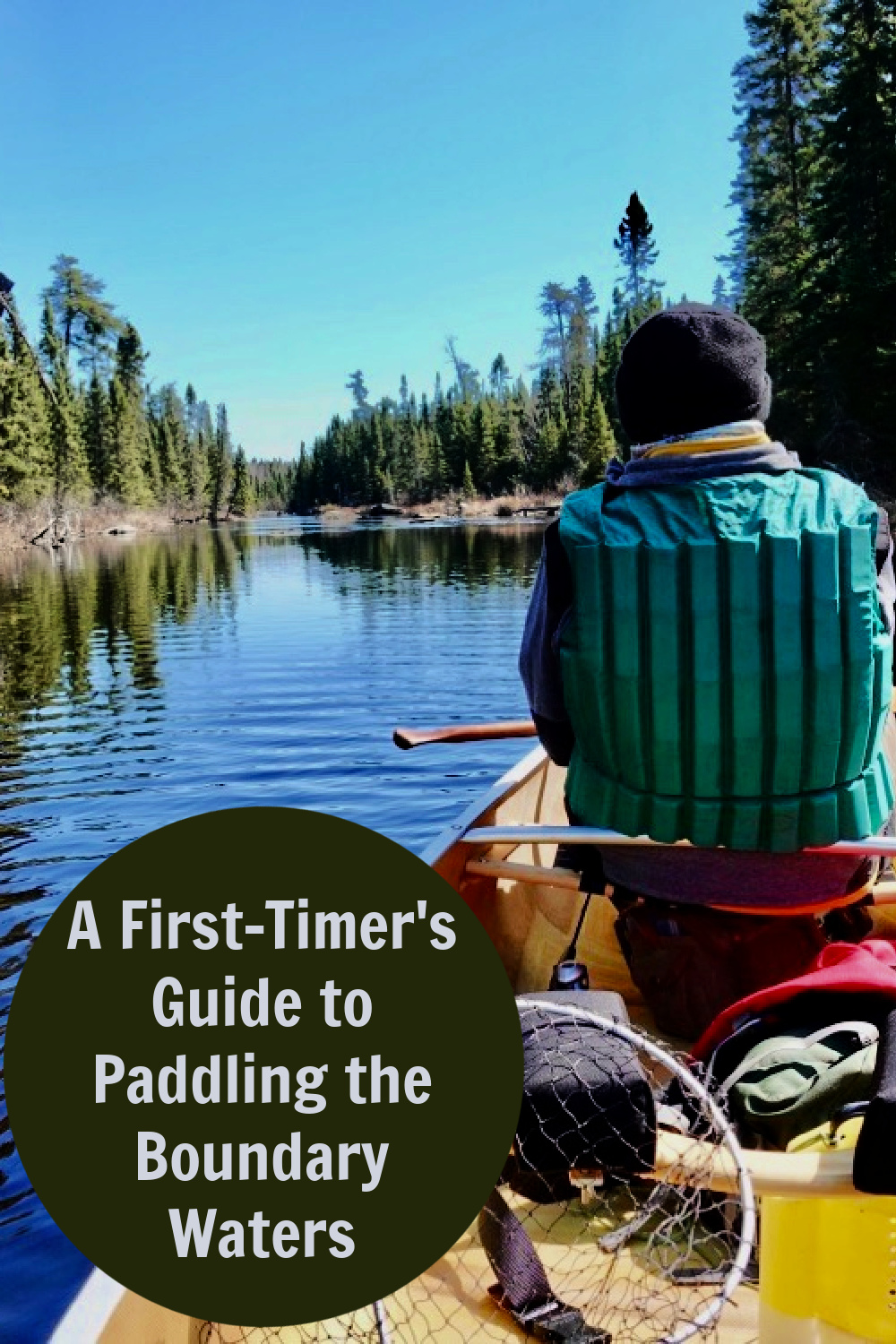
If you enjoyed this Boundary Waters trip planning guides, check out my other posts about the Boundary Waters region of northern Minnesota.

Hi! I’m Ada, a travel writer based in northern Minnesota, on a mission to see the world. I use this travel blog to provide practical, no-nonsense travel tips and itineraries for both domestic and international travels.
Home Airport:
European Christmas Markets
Where I’ve Been:
This is such a detailed post, thank you for sharing all your best tips! I’m from Wisconsin, so I’d love to get out and explore the Boundary Waters! 💙
I used to lead trips in the BWCA for Outward Bound so this post is very near and dear to me. You did an excellent job explaining everything in great detail. This post should be mandatory reading for everyone who wants to venture in the BWCA.
BWCA is such a magnificent place! I love the fact you address the mental preparation needed, a long trek there is no joke.

Ada is a travel writer based in northern Minnesota. She’s spent two decades as a freelance writer. She’s lived in three countries and has visited all 50 states. In addition to traveling the world, she runs a Boundary Waters outfitters and helps people plan canoe trips and other outdoor adventures in northeastern Minnesota.
Other Recent Articles
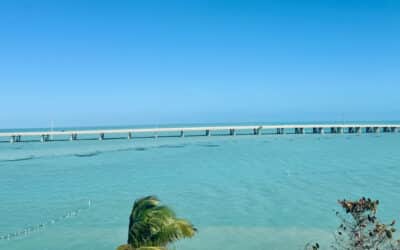
Best Stops On A Florida Keys Road Trip from Miami to Key West
Whether you’re driving from Miami to Key West or just day tripping on the Florida Keys Overseas Highway, you’ll want to include these 10 stops in your drive.

Key West Packing List For A December Visit
My Key West packing list has you covered with what to wear for a winter visit. My complete (& printable!) packing list makes packing for Key West, Florida a cinch.
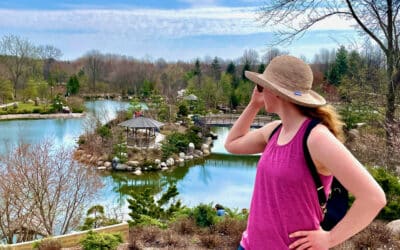
What To Do in Grand Rapids Michigan For A Stellar Weekend
Wondering what to do in Grand Rapids Michigan? This guide rounds up all the best things to do in Grand Rapids including restaurants, mansions, events, art, gardens, and more.
Thanks for signing up!
Enter the username on file and we'll send you a code to reset your password.
A verification code has been emailed to
Search teams locate body of one of two canoeists missing in Boundary Waters

Log in to share your opinion with MPR News and add it to your profile.
Thanks for liking this story! We have added it to a list of your favorite stories.
The body of one of two canoeists missing in the Boundary Waters Canoe Area Wilderness for nearly two weeks was located on Friday.
The St. Louis County Sheriff’s Office said the body of 41-year-old Jesse Haugen of Cambridge was found by search teams working near Curtain Falls, along the Canadian border.
The search will continue for 40-year-old Reis Grams of Lino Lakes.
The two men were among four canoeists who went over Curtain Falls , which drops 30 feet between Crooked and Iron Lakes in the wilderness about 20 miles north of Ely, on May 18. Another man was seriously injured.
Create a More Connected Minnesota
MPR News is your trusted resource for the news you need. With your support, MPR News brings accessible, courageous journalism and authentic conversation to everyone - free of paywalls and barriers. Your gift makes a difference.
Members of the sheriff’s office and the St. Louis County Rescue Squad have been battling challenging conditions in the search.
“Our biggest nemesis up there so far has been weather and Mother Nature. Because of the volume of water in the falls area and the temperatures and the time of year, it’s been a very difficult search situation,” said Nate Skelton, division commander with the St. Louis County Sheriff’s Office.
The sheriff’s office said flights to and from the scene are not available until Monday — so the crew at Curtain Falls on Friday will continue searching for Grams through the weekend.
The sheriff’s office said they’ve been using boats, canoes, drones and K-9 teams.
Last week a Minnesota National Guard CH-47 Chinook helicopter helped transport equipment , including a boat, to the remote search scene.
- Minneapolis incident report details chaotic, quickly-moving shooting scene
- Woodbury Alamo Drafthouse Cinema closes
- Authorities seek help finding missing 14-year-old who left St. Paul hospital
The Bodies of 2 Canoeists Who Went Over Waterfall in Minnesota's Boundary Waters Have Been Recovered
Law enforcement officials have found the bodies of two men who went over a waterfall while fishing in the Boundary Waters Canoe Area Wilderness of northern Minnesota
The Bodies of 2 Canoeists Who Went Over Waterfall in Minnesota's Boundary Waters Have Been Recovered
ELY, Minn. (AP) — Authorities have found the bodies of two men who went over a waterfall while fishing near the Minnesota-Ontario border last month.
Deputies found the remains of Melvin Grams, 40, of Lino Lakes, on Monday in the Boundary Waters Canoe Area Wilderness of northern Minnesota, the St. Louis County Sheriff’s Department announced. The agency located 41-year-old Cambridge resident Jesse Melvin Haugen's body on Friday.
The sheriff’s department has said Grams, Haugen and two others were fishing at the top of Curtain Falls between Crooked Lake and Iron Lake on the border last month. The group's two canoes went over the waterfall after paddlers in one boat tried to help the other canoeists. The two others survived, the Minnesota Star Tribune reported.
Bad weather had hampered the search for Grams and Haugen. The sheriff's department had said at points that cloud cover was too low for aerial surveillance, and rain kept a crew from searching until conditions improved.
Superior National Forest officials had closed trails, campsites, portages and bodies of water in the area, to assist in the search.
Copyright 2024 The Associated Press . All rights reserved. This material may not be published, broadcast, rewritten or redistributed.
Photos You Should See - May 2024

Join the Conversation
Tags: Associated Press , Minnesota
America 2024

Health News Bulletin
Stay informed on the latest news on health and COVID-19 from the editors at U.S. News & World Report.
Sign in to manage your newsletters »
Sign up to receive the latest updates from U.S News & World Report and our trusted partners and sponsors. By clicking submit, you are agreeing to our Terms and Conditions & Privacy Policy .
You May Also Like
The 10 worst presidents.
U.S. News Staff Feb. 23, 2024

Cartoons on President Donald Trump
Feb. 1, 2017, at 1:24 p.m.

Photos: Obama Behind the Scenes
April 8, 2022

Photos: Who Supports Joe Biden?
March 11, 2020

What to Know: Bird Flu Death in Mexico
Cecelia Smith-Schoenwalder June 6, 2024

Mental Health on College Campuses
Sarah Wood June 6, 2024

Q&A: Border Mayor Backs Biden Action
Elliott Davis Jr. June 6, 2024

Sounding the Alarm on Election Integrity
Aneeta Mathur-Ashton June 5, 2024

FCC Head Pushes AI Ad Plan

What to Know: Biden’s Trip to France
Laura Mannweiler June 5, 2024

Watch CBS News
Body of canoeist recovered in Boundary Waters, search continues for other missing man
By Aki Nace
May 31, 2024 / 3:46 PM CDT / CBS Minnesota
BOUNDARY WATERS, Minn. — The body of one of the two canoeists who went missing in the Boundary Waters Canoe Area Wilderness was recovered on Friday during a search near Curtain Falls.
Jesse Haugen, 41, was in a canoe that went over the falls on May 18 . Officials found his body on Friday, but search efforts continue for the second missing canoeist, Reis Grams of Lino Lakes.
Officials with the St. Louis County Sheriff's Office say two canoes went over the falls. Two people — one of whom was badly injured — were rescued from the area, which is near the Canadian border.
Crews will continue to search over the weekend, the sheriff's office says, though flights in and out of the area will be unavailable until Monday. Weather and water conditions are large factors in the search efforts, and more rain is expected in hte next few days.
Between eight and 12 people are on the ground at a base camp, utilizing boats, canoes, drones, and K-9 teams to search the area.
Last week, Gov. Tim Walz announced that four crew members and a helicopter from the Minnesota National Guard would head to the Boundary Waters to help with the search.
- Missing Person
Aki Nace has been a web producer for CBS Minnesota since 2019. She covers breaking news and makes short-form documentary films.
Featured Local Savings
More from cbs news.

Body of second canoeist recovered from Boundary Waters after two-week search

2 killed in head-on crash near Mankato

Vulnerable adult found safe in St. Cloud, police say

25-year-old woman dead after crash involving semi, vehicle carrying 3 children in southern Minnesota
Call us: 218-365-5581
Boy Scout High Adventure Canoe Trips for 2024
High adventure canoe trips for 2024, experience the boundary waters on your own terms.

Now is the time to plan your 2024 High Adventure Canoe Trips to the Boundary Waters. Our High Adventure Canoe Trips allow you to experience wilderness based your group’s goals. Making that happen is our primary function. We don’t dictate routes, pace, menus, or the number of people per canoe. Whatever your crew is coming to do, we will work with you to plan your route through the wilderness.
All High Adventure canoe trips are centered on your interests. Your itinerary is set by your ability level. Your route and pace is designed individually around you specific needs.
High Adventure Boundary Waters canoe trips offer a true wilderness experience. There are no roads through this area. Aircraft and motorboats are heavily restricted.
Our High Adventure Boundary Waters trips are 5 to 14 day wilderness canoe camping experiences. Typical treks cover 25 to 100 miles. You will travel through the Boundary Waters Canoe Area in Minnesota or Ontario’s Quetico Park . Our High Adventure Expedition Specials may be set-up to include both areas. All of our High Adventure trips start with private overnight lakeside accommodations at our lakeside canoe base. You may start and/or return directly from our docks. Other trips may start with van or boat transportation.
We are just six miles from Ely, Minnesota.
Nationally know anchorman Bill Kurtis narrates this 25 minute introduction to the Boundary Waters & Quetico Park, and North Country Canoe Outfitters

Our High Adventure Canoe Trips
All of our outfitting services are designed to give Boy Scout troops flexibility. YOUR High Adventure Boundary Waters crew:
- Sets the requirements for your participants to attend
- Determines the number of participants (starting with eight)
- Picks the number of days on the water (starting with five)
- Picks the arrival day of the week
- Picks whether to stay overnight before or after at our lake side base
- Picks the starting entry point location
- Picks the pace of the trip
- Picks the goals of the trip
- Picks the number of layover days on the trip (Of course we give our best advice for your needs on all of these)
Participants
The success of any high adventure program is more about the people you go with than the place you go .
A perfect trek may have crystal blue skies, comfortable temperatures, and no bugs. But it becomes a slow death march with a poorly prepared, poorly led crew. Likewise a few days hiking in the rain with a sharp crew leads to lifelong golden memories.
A High Adventure canoe trip should take your crew to a new level in the outdoors. It should develop the aims of Scouting:
- Growth in confidence,
- The opportunity to both lead and follow, and
- An appreciation for each crew member’s contribution to the group’s efforts.
Good equipment, good food, good surroundings, and good weather are all part of the picture. The biggest part is the challenge and satisfaction of accomplishing the goals of your high adventure canoe trip program. Setting these goals, knowing their importance, and preparing to meet them is the most important aspect of the trip. North Country can help with all of these.
2024 High Adventure Canoe Trip Packages
Our traditional Boy Scout canoe trip outfitting is complete. We use the same gear we offer to our private party customers.
First, what we DON’T do for a High Adventure canoe trip:
- require groups to bring their own sleeping bags, pads, utensils, cups and bowls
- insist jungle boots to be purchased
- make group buy extra copies of maps to be purchased at $50 to $90 per crew
- limit our supplied personal packs to one per three participants
- send nine people out in only three canoes
- we don’t use 72-pound aluminum canoes
Now, how WE do a High Adventure canoe trip instead:
- your clothing
- hygiene and grooming items
- fishing rods with basic tackle and lures
- group compass and first aid kit
- Foot ware should be rugged with closed toe and heal. They should drain easily.
- One set of maps, may be purchased ($16 to $32) as we plan your route with you, or bring your own
- Though we encourage two person’s personal items per pack, you may have as many as you need.
- The only time we recommend a 3-person canoe is for an odd number group size
- Our featured offering is a 2-person Royalex canoe (50-pound class): quiet for fishing, lighter for portaging. Our 64-pound aluminum canoes carry a $5/person/day discount: for the true novice, this canoe has the most stability on the market (short of some sort of outrigger set-up)
- We offer the most top quality group menu in the Boundary Waters featuring the 1st night out having a choice of Certified Angus Beef ® steaks or a pair of 1/3 pound Angus burgers.
- Most groups opt to spend the night before their trip in our lakeside bunkrooms (included) versus a motel in town.
High Adventure Canoe Trip Expedition Specials
Back in 2016 we introduced a new concept in Boy Scout High Adventures. Our Expedition Specials are keyed to the type of Boy Scout canoe trip your crew wants to experience. These High Adventure canoe trips are each set for a fixed number of days. All five canoe trips are outfitted, supplied, and priced for eight person crews. They are designed to start on specific days of the week. Should you need to change to another weekday, deductions are offered, or supplements are needed.
All of our Expedition Specials include:
- All gear and menu offerings listed in our Leader’s Guide
- Four “Two-to-a-canoe” Royalex canoes for your crew
- Staff briefing on equipment use, menu review, portaging skills
- Private overnight bunkrooms at our lakeside base before & after
- Fast start, full, hot, continental breakfast at our base on morning #1
- Van transportation to starting points, and from exit points
- Use of our campfire ring for your closing fellowship
- Boundary Waters patch for each participant
WILDERNESS 50 – MILER EXPEDITION SPECIAL
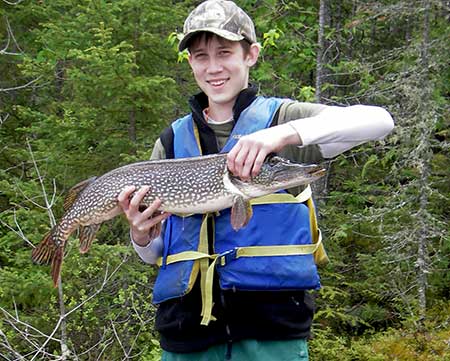
Imagine your “fish’in buddy” landing a trophy fish
In doing research for this Expedition Special, we found there are a lot of differing opinions about what the Boy Scout 50-Miler Program is all about. Most agreed it should be hard ; but that doesn’t mean brutal . In the north country, a 50-miler trip in 5 days requires a pace beyond what many Scouts and Scouters are capable of doing. An hour or two is needed each day to take down camp in the morning. Add another hour or two to set it up at the end of the day. Time is needed for meal preparation and clean-up. Then add in two hours per day for the 10 hour service project. The result is paddlers trying to cover 10-12 miles, with portages, in four to five hours day after day.
This trip is ideal for a Saturday afternoon arrival. Your 7-day High adventure Canoe Trip Expedition Special runs from Sunday to Saturday. Your last evening’s bunkroom is included, with departing for home on Sunday morning.
8 Participants All Inclusive Price: $6000 Bottom Line with tax exemption certificate. If arriving on Tuesday, Wednesday, or Thursday afternoon, deduct $400 per crew of 8.
Canoe Camping
Youth groups, bwca fishing, ncco: your outfitter, about the bwca.
Restaurant Globus

RESTAURANT GLOBUS, Elektrostal - Restaurant Reviews & Photos - Tripadvisor

Body of final missing canoeist recovered near Curtain Falls in Boundary Waters
T he body of Reis Melvin Grams, the final canoeist missing since an accident at Curtain Falls in the Boundary Waters Canoe Area Wilderness, was recovered Monday morning, according to the St. Louis County Sheriff's Office.
Grams, 40, of Lino Lakes, was found west of the site of the May 18 accident. His body was flown by plane to the Ely seaplane base. Searchers, including the St. Louis County Rescue Squad, recovered Jesse Haugen , the other missing canoeist, last week.
On the day of the incident, authorities received a call that two canoes had gone over Curtain Falls. One had been in distress and the other assisting. Two men, Grams and Haugen, were missing and one was badly injured. The search for the men lasted more than two weeks and included help from the National Guard.
Grams was a co-owner of Touchdown Tile in Ham Lake, according to his Facebook page. He and his wife, Angie Grams, have two young sons.
Kyle Sellers of Ham Lake and Erik Grams, brother of Reis, survived going over the waterfall, while Jared Lohse, of Cambridge, remained at the group's campsite.
©2024 StarTribune. Visit startribune.com. Distributed by Tribune Content Agency, LLC.
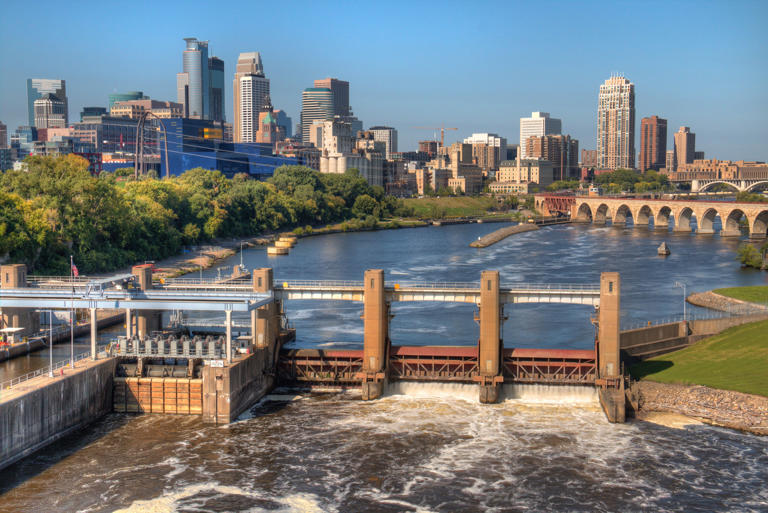

IMAGES
VIDEO
COMMENTS
Accessible primarily by canoe, the Boundary Waters in northern Minnesota is one of America's most beautiful and remote adventures. Plan your first trip using this four-day beginner-friendly itinerary. One of the hardest things about planning your first Boundary Waters trip is deciding where to go within the vast preserve's 1,200 miles of canoe routes, 11 hiking trails and approximately 2,000 ...
Discover your next Boundary Waters adventure with our easy-to-use BWCA route finding tool! Complete with entry points, route info and more!
Trip planning Directions to Boundary Waters. The Boundary Waters gateway town of Ely, Minnesota is located about 250 miles north of Minneapolis-St. Paul on I-35. From Duluth, take Highway 61 and then head north on County Highway 2, Service Highway 15 and State Highway 1 for a backroads driving experience.
Best 7-day Boundary Waters canoe trip Sawbill Southern Boundary. Starting from the Sawbill Trail at entry point 50, this epic 62-mile Boundary Waters canoe route has 52 portages. Don't let that dissuade you. Choose a lightweight canoe and pack carefully to reap the rewards of secret lakes and great wildlife viewing opportunities in the remote ...
For over 40 canoe trip seasons we have been one of the leading Boundary Waters outfitters in Ely, Minnesota.. We outfit BWCA canoe trips with top-quality gear and meals for both the Boundary Waters Canoe Area Wilderness in northern Minnesota and Quetico Park in Canada. Trips may start or end from our lakeside Ely, Minnesota, outfitting base or the dozens of unique starting locations we serve ...
The Boundary Waters are a vast and remote wilderness. Located along the U.S.-Canadian border between Minnesota and Ontario, the Boundary Waters have been a popular destination for explorers, adventurers, and active travelers for decades. Spread out over more than a million acres of wilderness, this region is made up of dense forests, sprawling ...
About the Boundary Waters Canoe Area (BWCA) Minnesota and Quetico. Tips On BWCA Canoe Trip Routes. Your trip through the wilderness will only be as good — or as bad — as the route you travel. There is no one route that is best, and there is no one entry point that is best. BWCA Routes can change a great deal over the course of a summer.
of Trip to Take. There are many ways to explore the Boundary Waters, but the two most popular modes of travel are hiking and canoeing. Canoeing. Northeastern Minnesota is created for canoeing. This is the best canoe country in the United States, a place where each year thousands of lives are transformed. Hiking.
Stone Harbor Wilderness Supply. Based in Grand Marais, Stone Harbor Wilderness Supply offers Boundary Waters canoe day trips starting at $150 per person and a four-day guided kayak camping trip on sprawling Saganaga Lake starting at $725 per person. Photo: Britta Bjur // @brittabjur.
Now is the time to reserve your Boundary Waters canoe trip with River Point Outfitting Co. Ely Outfitters™. BWCA trips are amazing, and USFS Travel Permits always sell quickly so reserve your paddling adventure soon. Call Today! We'll take care of everything! 1-218-365-6604 ...
Planning a Boundary Waters canoe trip in the Boundary Waters Canoe Area Wilderness (BWCA) involves navigating a labyrinth of over 1,000 lakes and islands. Located on the Minnesota/Canada border, I've made countless trips to the BWCA ever since I was a kid and it always delivers when I want a quiet week filled with great views and adventure.
Make just one trip to the Boundary Waters Canoe Area Wilderness, and your life will be changed forever. This pristine wilderness extends along 150 miles of the US/Canada border in Northern Minnesota and looks much the same as it did in the early 1900s when preservation efforts began. More than 1,000 lakes and hundreds of miles of rivers and ...
The Boundary Waters Canoe Area Wilderness (BWCAW, or simply BWCA) is our nation's only large lakeland wilderness, where travel during the ice-free months is primarily via canoe. At over 1 million acres, the area remains the largest wilderness east of the Rockies and north of Florida's Everglades, and the storied Boundary Waters remains the ...
60 days before your trip, you should: Decide on a menu and split up food-buying duties. Make one person responsible for buying all the breakfast food, another for lunch, and a third for dinner. Make reservations for any gear you might need with the outfitter of your choice.
1) The Vento Unit accessed from the east side of the Gunflint Trail and the end of the Arrowhead Trail in Hovland. 2) The largest "main" section of the Boundary Waters that stretches from Gunflint Lake all the way to Ely and Crane Lake. 3) The La Croix unit in between Burntside and Vermillion Lakes.
Then, by applying their professional expertise, make a recommendation based on what the party has in mind. While it may still be "XYZ Lake," it could be Little Indian Sioux River, Mudro Lake, Moose Lake, Island River or Farm Lake. We utilize 24 entry points into the BWCA, and 11 into Quetico Park.
The body of one of two canoeists missing in the Boundary Waters Canoe Area Wilderness for nearly two weeks was located on Friday. The St. Louis County Sheriff's Office said the body of 41-year ...
Deputies found the remains of Melvin Grams, 40, of Lino Lakes, on Monday in the Boundary Waters Canoe Area Wilderness of northern Minnesota, the St. Louis County Sheriff's Department announced.
Zillow has 7 photos of this $390,000 3 beds, 2 baths, 2,093 Square Feet single family home located at 8258 Boundary Waters Dr, Porter, TX 77365 built in 2024. MLS #20997005.
Ely, Minn. (AP) — Authorities have found the bodies of two men who went over a waterfall while fishing near the Minnesota-Ontario border last month.. Deputies found the remains of Melvin Grams, 40, of Lino Lakes, on Monday in the Boundary Waters Canoe Area Wilderness of northern Minnesota, the St. Louis County Sheriff's Department announced.
Morning headlines from May 31, 2024 03:05. BOUNDARY WATERS, Minn. — The body of one of the two canoeists who went missing in the Boundary Waters Canoe Area Wilderness was recovered on Friday ...
Our High Adventure Boundary Waters trips are 5 to 14 day wilderness canoe camping experiences. Typical treks cover 25 to 100 miles. You will travel through the Boundary Waters Canoe Area in Minnesota or Ontario's Quetico Park. Our High Adventure Expedition Specials may be set-up to include both areas.
Elektrostal Hotel, Elektrostal: See 25 traveler reviews, 44 candid photos, and great deals for Elektrostal Hotel, ranked #1 of 2 B&Bs / inns in Elektrostal and rated 4 of 5 at Tripadvisor.
Review. Share. 67 reviews. #2 of 28 Restaurants in Elektrostal $$ - $$$, European, Contemporary, Vegetarian Friendly. Fryazevskoye Hwy., 14, Elektrostal Russia. + Add phone number + Add website + Add hours Improve this listing. There aren't enough food, service, value or atmosphere ratings for Restaurant Globus yet.
In 1938, it was granted town status. [citation needed]Administrative and municipal status. Within the framework of administrative divisions, it is incorporated as Elektrostal City Under Oblast Jurisdiction—an administrative unit with the status equal to that of the districts. As a municipal division, Elektrostal City Under Oblast Jurisdiction is incorporated as Elektrostal Urban Okrug.
The body of Reis Melvin Grams, the final canoeist missing since an accident at Curtain Falls in the Boundary Waters Canoe Area Wilderness, was recovered Monday morning, according to the St. Louis ...
Elektrostal. Elektrostal ( Russian: Электроста́ль) is a city in Moscow Oblast, Russia. It is 58 kilometers (36 mi) east of Moscow. As of 2010, 155,196 people lived there.